Kinesiology Aerobic Training Article 2022
VerifiedAdded on 2022/10/04
|22
|5434
|60
AI Summary
Contribute Materials
Your contribution can guide someone’s learning journey. Share your
documents today.

Running head: KINESIOLOGY 1
Kinesiology
Name
Institution
Kinesiology
Name
Institution
Secure Best Marks with AI Grader
Need help grading? Try our AI Grader for instant feedback on your assignments.
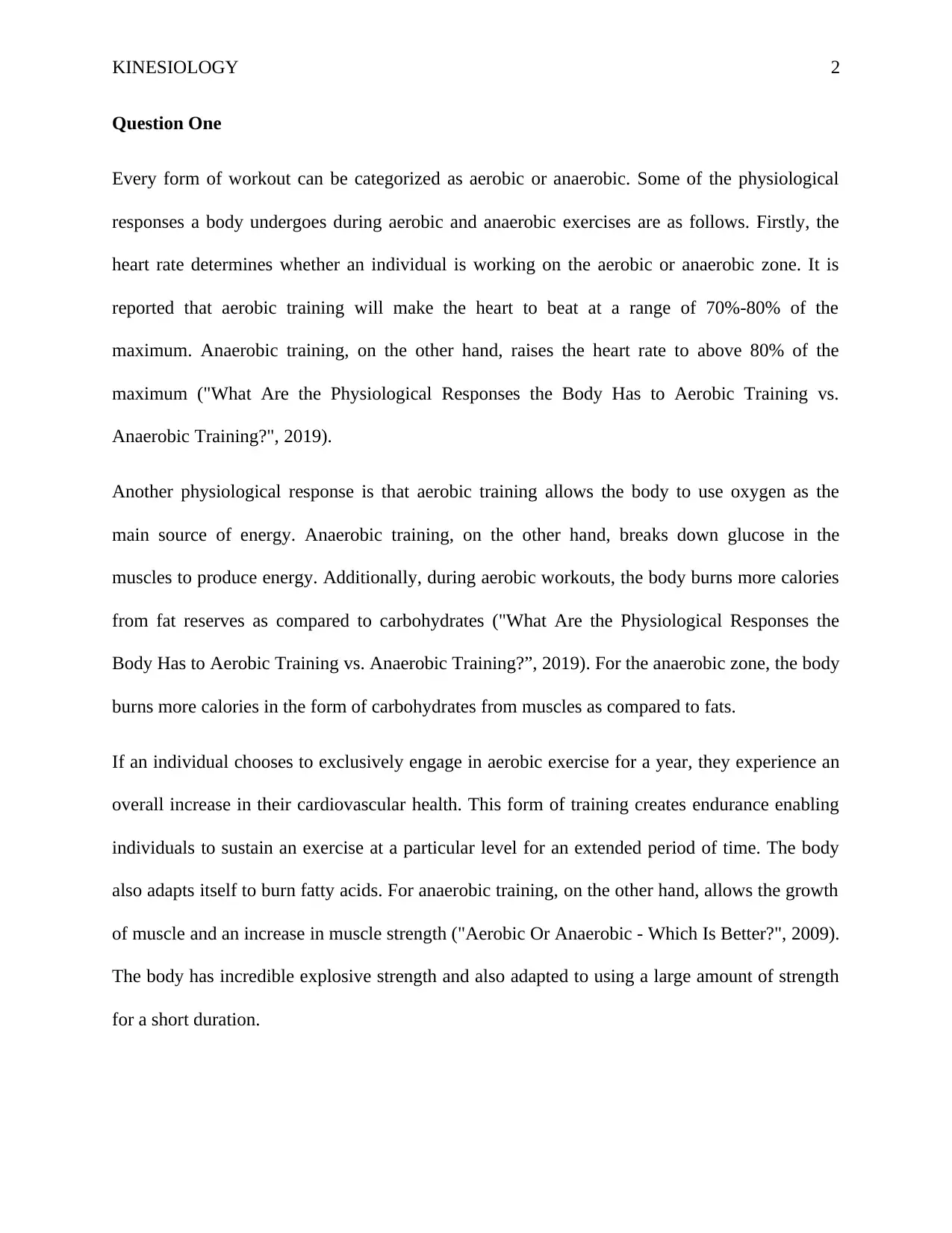
KINESIOLOGY 2
Question One
Every form of workout can be categorized as aerobic or anaerobic. Some of the physiological
responses a body undergoes during aerobic and anaerobic exercises are as follows. Firstly, the
heart rate determines whether an individual is working on the aerobic or anaerobic zone. It is
reported that aerobic training will make the heart to beat at a range of 70%-80% of the
maximum. Anaerobic training, on the other hand, raises the heart rate to above 80% of the
maximum ("What Are the Physiological Responses the Body Has to Aerobic Training vs.
Anaerobic Training?", 2019).
Another physiological response is that aerobic training allows the body to use oxygen as the
main source of energy. Anaerobic training, on the other hand, breaks down glucose in the
muscles to produce energy. Additionally, during aerobic workouts, the body burns more calories
from fat reserves as compared to carbohydrates ("What Are the Physiological Responses the
Body Has to Aerobic Training vs. Anaerobic Training?”, 2019). For the anaerobic zone, the body
burns more calories in the form of carbohydrates from muscles as compared to fats.
If an individual chooses to exclusively engage in aerobic exercise for a year, they experience an
overall increase in their cardiovascular health. This form of training creates endurance enabling
individuals to sustain an exercise at a particular level for an extended period of time. The body
also adapts itself to burn fatty acids. For anaerobic training, on the other hand, allows the growth
of muscle and an increase in muscle strength ("Aerobic Or Anaerobic - Which Is Better?", 2009).
The body has incredible explosive strength and also adapted to using a large amount of strength
for a short duration.
Question One
Every form of workout can be categorized as aerobic or anaerobic. Some of the physiological
responses a body undergoes during aerobic and anaerobic exercises are as follows. Firstly, the
heart rate determines whether an individual is working on the aerobic or anaerobic zone. It is
reported that aerobic training will make the heart to beat at a range of 70%-80% of the
maximum. Anaerobic training, on the other hand, raises the heart rate to above 80% of the
maximum ("What Are the Physiological Responses the Body Has to Aerobic Training vs.
Anaerobic Training?", 2019).
Another physiological response is that aerobic training allows the body to use oxygen as the
main source of energy. Anaerobic training, on the other hand, breaks down glucose in the
muscles to produce energy. Additionally, during aerobic workouts, the body burns more calories
from fat reserves as compared to carbohydrates ("What Are the Physiological Responses the
Body Has to Aerobic Training vs. Anaerobic Training?”, 2019). For the anaerobic zone, the body
burns more calories in the form of carbohydrates from muscles as compared to fats.
If an individual chooses to exclusively engage in aerobic exercise for a year, they experience an
overall increase in their cardiovascular health. This form of training creates endurance enabling
individuals to sustain an exercise at a particular level for an extended period of time. The body
also adapts itself to burn fatty acids. For anaerobic training, on the other hand, allows the growth
of muscle and an increase in muscle strength ("Aerobic Or Anaerobic - Which Is Better?", 2009).
The body has incredible explosive strength and also adapted to using a large amount of strength
for a short duration.
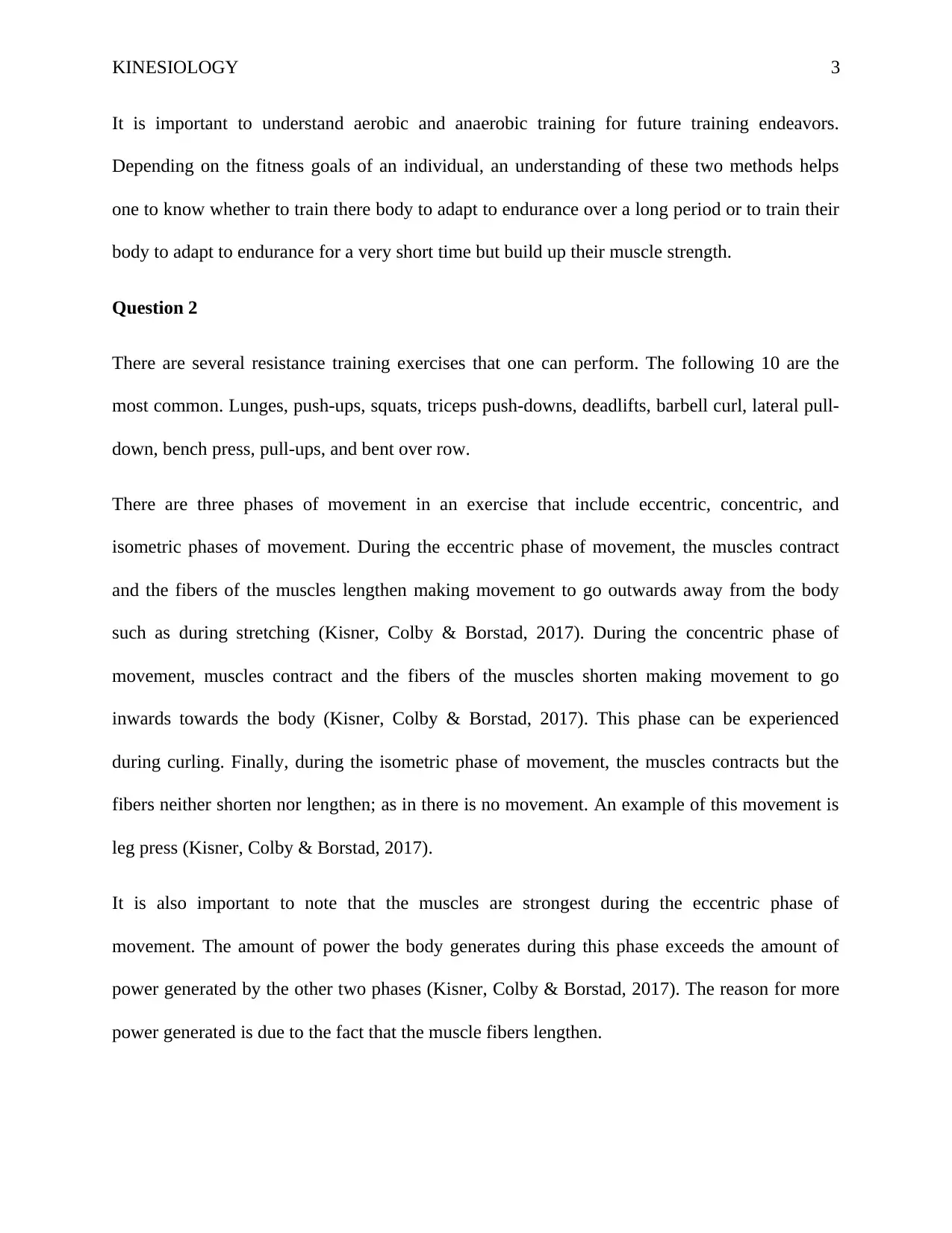
KINESIOLOGY 3
It is important to understand aerobic and anaerobic training for future training endeavors.
Depending on the fitness goals of an individual, an understanding of these two methods helps
one to know whether to train there body to adapt to endurance over a long period or to train their
body to adapt to endurance for a very short time but build up their muscle strength.
Question 2
There are several resistance training exercises that one can perform. The following 10 are the
most common. Lunges, push-ups, squats, triceps push-downs, deadlifts, barbell curl, lateral pull-
down, bench press, pull-ups, and bent over row.
There are three phases of movement in an exercise that include eccentric, concentric, and
isometric phases of movement. During the eccentric phase of movement, the muscles contract
and the fibers of the muscles lengthen making movement to go outwards away from the body
such as during stretching (Kisner, Colby & Borstad, 2017). During the concentric phase of
movement, muscles contract and the fibers of the muscles shorten making movement to go
inwards towards the body (Kisner, Colby & Borstad, 2017). This phase can be experienced
during curling. Finally, during the isometric phase of movement, the muscles contracts but the
fibers neither shorten nor lengthen; as in there is no movement. An example of this movement is
leg press (Kisner, Colby & Borstad, 2017).
It is also important to note that the muscles are strongest during the eccentric phase of
movement. The amount of power the body generates during this phase exceeds the amount of
power generated by the other two phases (Kisner, Colby & Borstad, 2017). The reason for more
power generated is due to the fact that the muscle fibers lengthen.
It is important to understand aerobic and anaerobic training for future training endeavors.
Depending on the fitness goals of an individual, an understanding of these two methods helps
one to know whether to train there body to adapt to endurance over a long period or to train their
body to adapt to endurance for a very short time but build up their muscle strength.
Question 2
There are several resistance training exercises that one can perform. The following 10 are the
most common. Lunges, push-ups, squats, triceps push-downs, deadlifts, barbell curl, lateral pull-
down, bench press, pull-ups, and bent over row.
There are three phases of movement in an exercise that include eccentric, concentric, and
isometric phases of movement. During the eccentric phase of movement, the muscles contract
and the fibers of the muscles lengthen making movement to go outwards away from the body
such as during stretching (Kisner, Colby & Borstad, 2017). During the concentric phase of
movement, muscles contract and the fibers of the muscles shorten making movement to go
inwards towards the body (Kisner, Colby & Borstad, 2017). This phase can be experienced
during curling. Finally, during the isometric phase of movement, the muscles contracts but the
fibers neither shorten nor lengthen; as in there is no movement. An example of this movement is
leg press (Kisner, Colby & Borstad, 2017).
It is also important to note that the muscles are strongest during the eccentric phase of
movement. The amount of power the body generates during this phase exceeds the amount of
power generated by the other two phases (Kisner, Colby & Borstad, 2017). The reason for more
power generated is due to the fact that the muscle fibers lengthen.
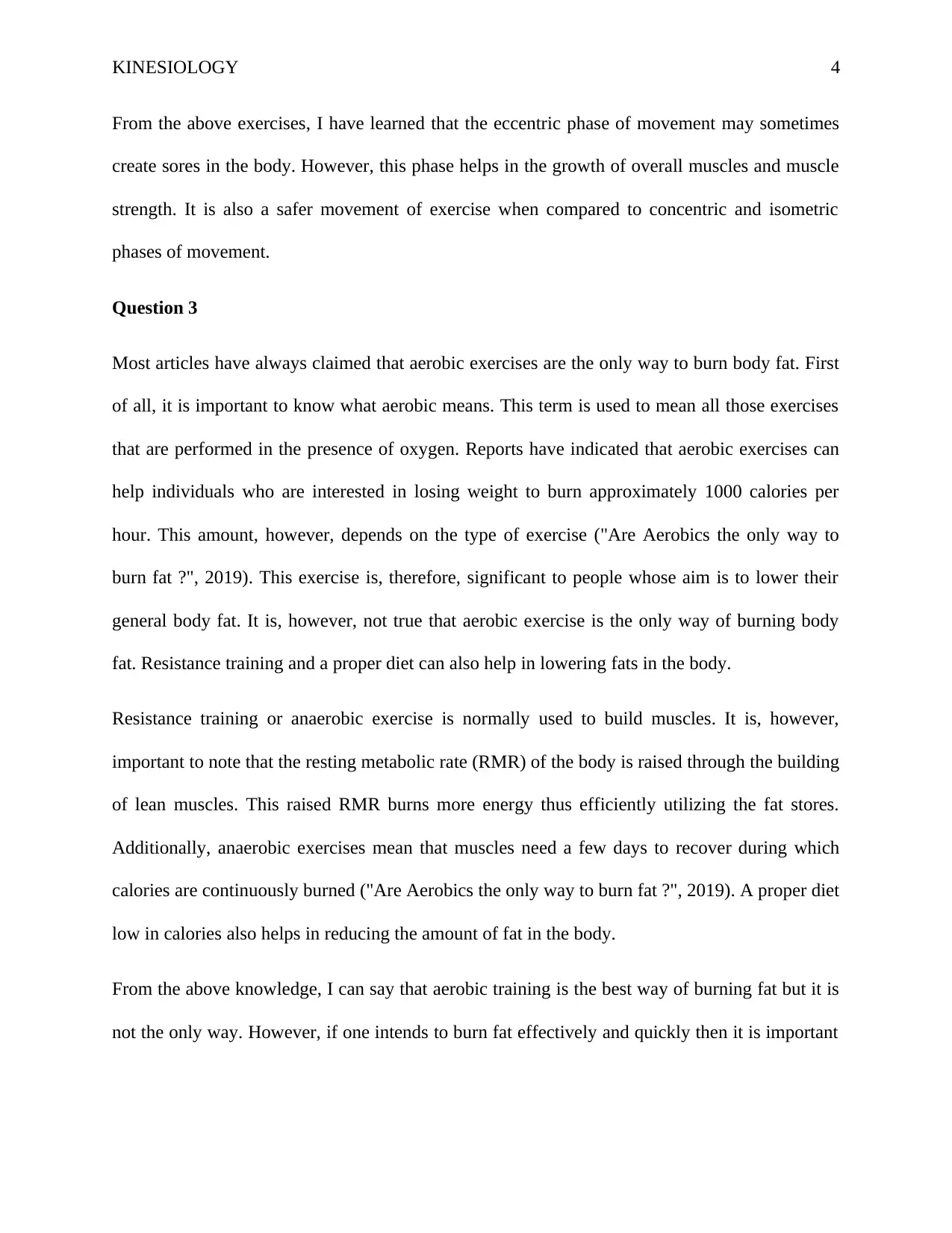
KINESIOLOGY 4
From the above exercises, I have learned that the eccentric phase of movement may sometimes
create sores in the body. However, this phase helps in the growth of overall muscles and muscle
strength. It is also a safer movement of exercise when compared to concentric and isometric
phases of movement.
Question 3
Most articles have always claimed that aerobic exercises are the only way to burn body fat. First
of all, it is important to know what aerobic means. This term is used to mean all those exercises
that are performed in the presence of oxygen. Reports have indicated that aerobic exercises can
help individuals who are interested in losing weight to burn approximately 1000 calories per
hour. This amount, however, depends on the type of exercise ("Are Aerobics the only way to
burn fat ?", 2019). This exercise is, therefore, significant to people whose aim is to lower their
general body fat. It is, however, not true that aerobic exercise is the only way of burning body
fat. Resistance training and a proper diet can also help in lowering fats in the body.
Resistance training or anaerobic exercise is normally used to build muscles. It is, however,
important to note that the resting metabolic rate (RMR) of the body is raised through the building
of lean muscles. This raised RMR burns more energy thus efficiently utilizing the fat stores.
Additionally, anaerobic exercises mean that muscles need a few days to recover during which
calories are continuously burned ("Are Aerobics the only way to burn fat ?", 2019). A proper diet
low in calories also helps in reducing the amount of fat in the body.
From the above knowledge, I can say that aerobic training is the best way of burning fat but it is
not the only way. However, if one intends to burn fat effectively and quickly then it is important
From the above exercises, I have learned that the eccentric phase of movement may sometimes
create sores in the body. However, this phase helps in the growth of overall muscles and muscle
strength. It is also a safer movement of exercise when compared to concentric and isometric
phases of movement.
Question 3
Most articles have always claimed that aerobic exercises are the only way to burn body fat. First
of all, it is important to know what aerobic means. This term is used to mean all those exercises
that are performed in the presence of oxygen. Reports have indicated that aerobic exercises can
help individuals who are interested in losing weight to burn approximately 1000 calories per
hour. This amount, however, depends on the type of exercise ("Are Aerobics the only way to
burn fat ?", 2019). This exercise is, therefore, significant to people whose aim is to lower their
general body fat. It is, however, not true that aerobic exercise is the only way of burning body
fat. Resistance training and a proper diet can also help in lowering fats in the body.
Resistance training or anaerobic exercise is normally used to build muscles. It is, however,
important to note that the resting metabolic rate (RMR) of the body is raised through the building
of lean muscles. This raised RMR burns more energy thus efficiently utilizing the fat stores.
Additionally, anaerobic exercises mean that muscles need a few days to recover during which
calories are continuously burned ("Are Aerobics the only way to burn fat ?", 2019). A proper diet
low in calories also helps in reducing the amount of fat in the body.
From the above knowledge, I can say that aerobic training is the best way of burning fat but it is
not the only way. However, if one intends to burn fat effectively and quickly then it is important
Secure Best Marks with AI Grader
Need help grading? Try our AI Grader for instant feedback on your assignments.
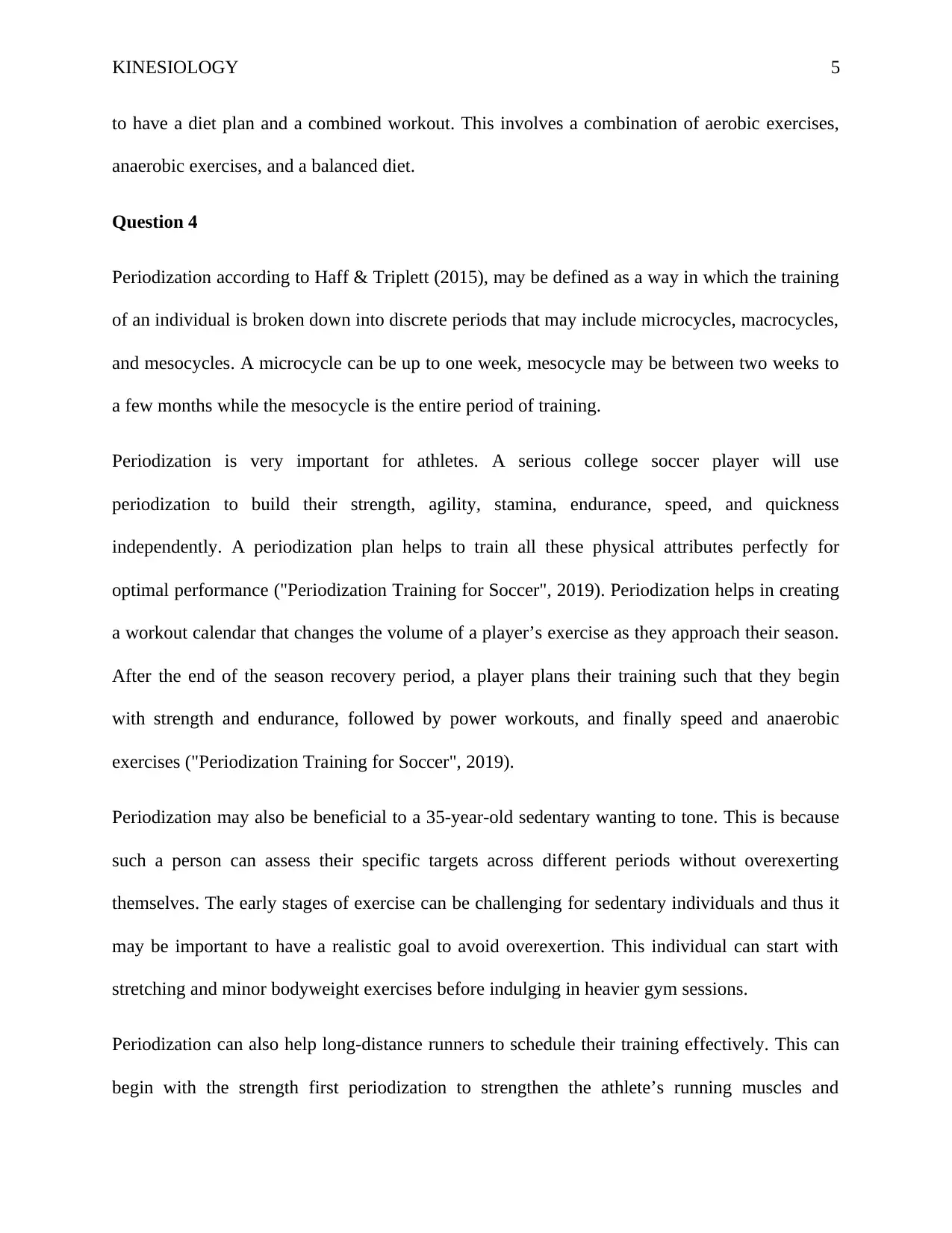
KINESIOLOGY 5
to have a diet plan and a combined workout. This involves a combination of aerobic exercises,
anaerobic exercises, and a balanced diet.
Question 4
Periodization according to Haff & Triplett (2015), may be defined as a way in which the training
of an individual is broken down into discrete periods that may include microcycles, macrocycles,
and mesocycles. A microcycle can be up to one week, mesocycle may be between two weeks to
a few months while the mesocycle is the entire period of training.
Periodization is very important for athletes. A serious college soccer player will use
periodization to build their strength, agility, stamina, endurance, speed, and quickness
independently. A periodization plan helps to train all these physical attributes perfectly for
optimal performance ("Periodization Training for Soccer", 2019). Periodization helps in creating
a workout calendar that changes the volume of a player’s exercise as they approach their season.
After the end of the season recovery period, a player plans their training such that they begin
with strength and endurance, followed by power workouts, and finally speed and anaerobic
exercises ("Periodization Training for Soccer", 2019).
Periodization may also be beneficial to a 35-year-old sedentary wanting to tone. This is because
such a person can assess their specific targets across different periods without overexerting
themselves. The early stages of exercise can be challenging for sedentary individuals and thus it
may be important to have a realistic goal to avoid overexertion. This individual can start with
stretching and minor bodyweight exercises before indulging in heavier gym sessions.
Periodization can also help long-distance runners to schedule their training effectively. This can
begin with the strength first periodization to strengthen the athlete’s running muscles and
to have a diet plan and a combined workout. This involves a combination of aerobic exercises,
anaerobic exercises, and a balanced diet.
Question 4
Periodization according to Haff & Triplett (2015), may be defined as a way in which the training
of an individual is broken down into discrete periods that may include microcycles, macrocycles,
and mesocycles. A microcycle can be up to one week, mesocycle may be between two weeks to
a few months while the mesocycle is the entire period of training.
Periodization is very important for athletes. A serious college soccer player will use
periodization to build their strength, agility, stamina, endurance, speed, and quickness
independently. A periodization plan helps to train all these physical attributes perfectly for
optimal performance ("Periodization Training for Soccer", 2019). Periodization helps in creating
a workout calendar that changes the volume of a player’s exercise as they approach their season.
After the end of the season recovery period, a player plans their training such that they begin
with strength and endurance, followed by power workouts, and finally speed and anaerobic
exercises ("Periodization Training for Soccer", 2019).
Periodization may also be beneficial to a 35-year-old sedentary wanting to tone. This is because
such a person can assess their specific targets across different periods without overexerting
themselves. The early stages of exercise can be challenging for sedentary individuals and thus it
may be important to have a realistic goal to avoid overexertion. This individual can start with
stretching and minor bodyweight exercises before indulging in heavier gym sessions.
Periodization can also help long-distance runners to schedule their training effectively. This can
begin with the strength first periodization to strengthen the athlete’s running muscles and
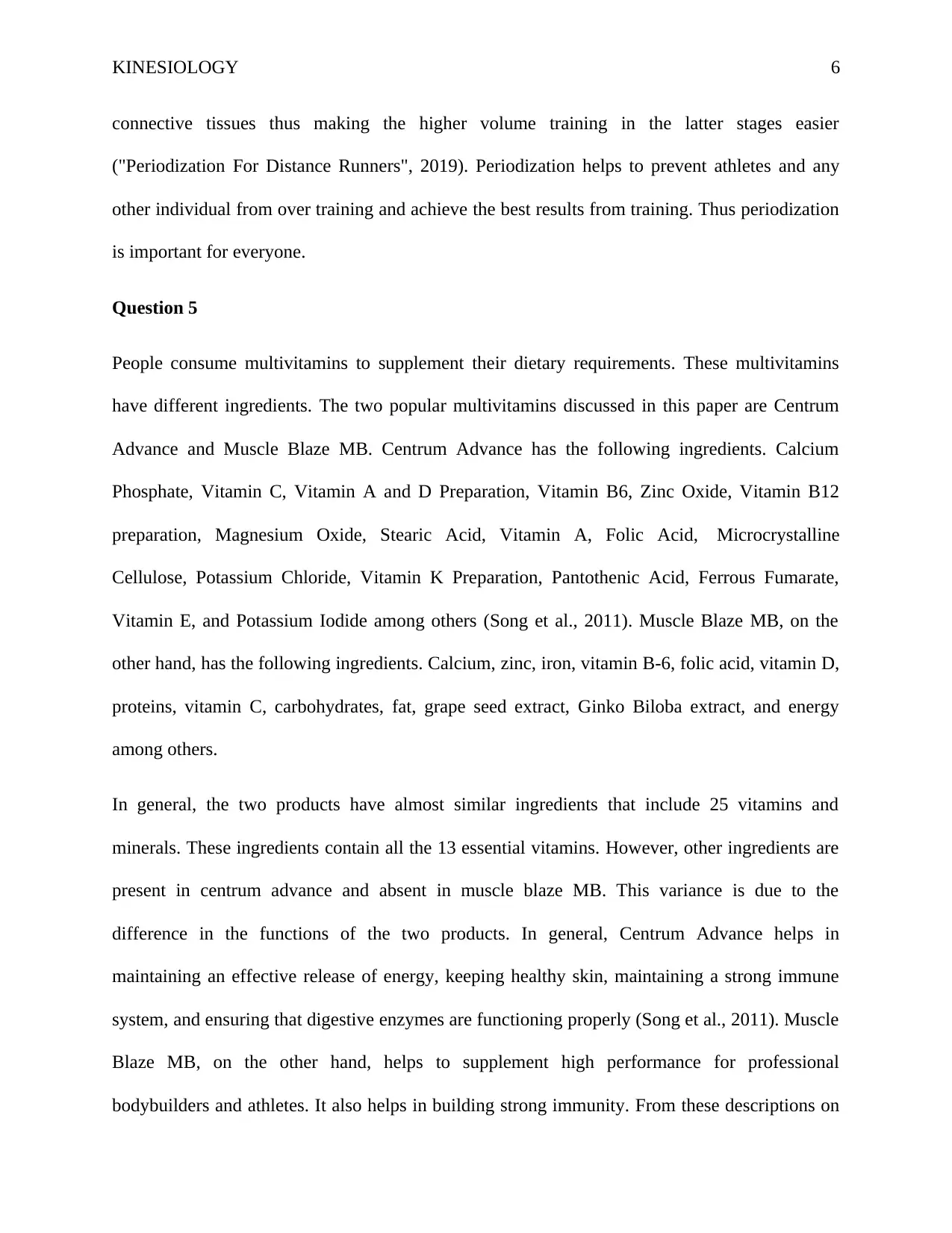
KINESIOLOGY 6
connective tissues thus making the higher volume training in the latter stages easier
("Periodization For Distance Runners", 2019). Periodization helps to prevent athletes and any
other individual from over training and achieve the best results from training. Thus periodization
is important for everyone.
Question 5
People consume multivitamins to supplement their dietary requirements. These multivitamins
have different ingredients. The two popular multivitamins discussed in this paper are Centrum
Advance and Muscle Blaze MB. Centrum Advance has the following ingredients. Calcium
Phosphate, Vitamin C, Vitamin A and D Preparation, Vitamin B6, Zinc Oxide, Vitamin B12
preparation, Magnesium Oxide, Stearic Acid, Vitamin A, Folic Acid, Microcrystalline
Cellulose, Potassium Chloride, Vitamin K Preparation, Pantothenic Acid, Ferrous Fumarate,
Vitamin E, and Potassium Iodide among others (Song et al., 2011). Muscle Blaze MB, on the
other hand, has the following ingredients. Calcium, zinc, iron, vitamin B-6, folic acid, vitamin D,
proteins, vitamin C, carbohydrates, fat, grape seed extract, Ginko Biloba extract, and energy
among others.
In general, the two products have almost similar ingredients that include 25 vitamins and
minerals. These ingredients contain all the 13 essential vitamins. However, other ingredients are
present in centrum advance and absent in muscle blaze MB. This variance is due to the
difference in the functions of the two products. In general, Centrum Advance helps in
maintaining an effective release of energy, keeping healthy skin, maintaining a strong immune
system, and ensuring that digestive enzymes are functioning properly (Song et al., 2011). Muscle
Blaze MB, on the other hand, helps to supplement high performance for professional
bodybuilders and athletes. It also helps in building strong immunity. From these descriptions on
connective tissues thus making the higher volume training in the latter stages easier
("Periodization For Distance Runners", 2019). Periodization helps to prevent athletes and any
other individual from over training and achieve the best results from training. Thus periodization
is important for everyone.
Question 5
People consume multivitamins to supplement their dietary requirements. These multivitamins
have different ingredients. The two popular multivitamins discussed in this paper are Centrum
Advance and Muscle Blaze MB. Centrum Advance has the following ingredients. Calcium
Phosphate, Vitamin C, Vitamin A and D Preparation, Vitamin B6, Zinc Oxide, Vitamin B12
preparation, Magnesium Oxide, Stearic Acid, Vitamin A, Folic Acid, Microcrystalline
Cellulose, Potassium Chloride, Vitamin K Preparation, Pantothenic Acid, Ferrous Fumarate,
Vitamin E, and Potassium Iodide among others (Song et al., 2011). Muscle Blaze MB, on the
other hand, has the following ingredients. Calcium, zinc, iron, vitamin B-6, folic acid, vitamin D,
proteins, vitamin C, carbohydrates, fat, grape seed extract, Ginko Biloba extract, and energy
among others.
In general, the two products have almost similar ingredients that include 25 vitamins and
minerals. These ingredients contain all the 13 essential vitamins. However, other ingredients are
present in centrum advance and absent in muscle blaze MB. This variance is due to the
difference in the functions of the two products. In general, Centrum Advance helps in
maintaining an effective release of energy, keeping healthy skin, maintaining a strong immune
system, and ensuring that digestive enzymes are functioning properly (Song et al., 2011). Muscle
Blaze MB, on the other hand, helps to supplement high performance for professional
bodybuilders and athletes. It also helps in building strong immunity. From these descriptions on
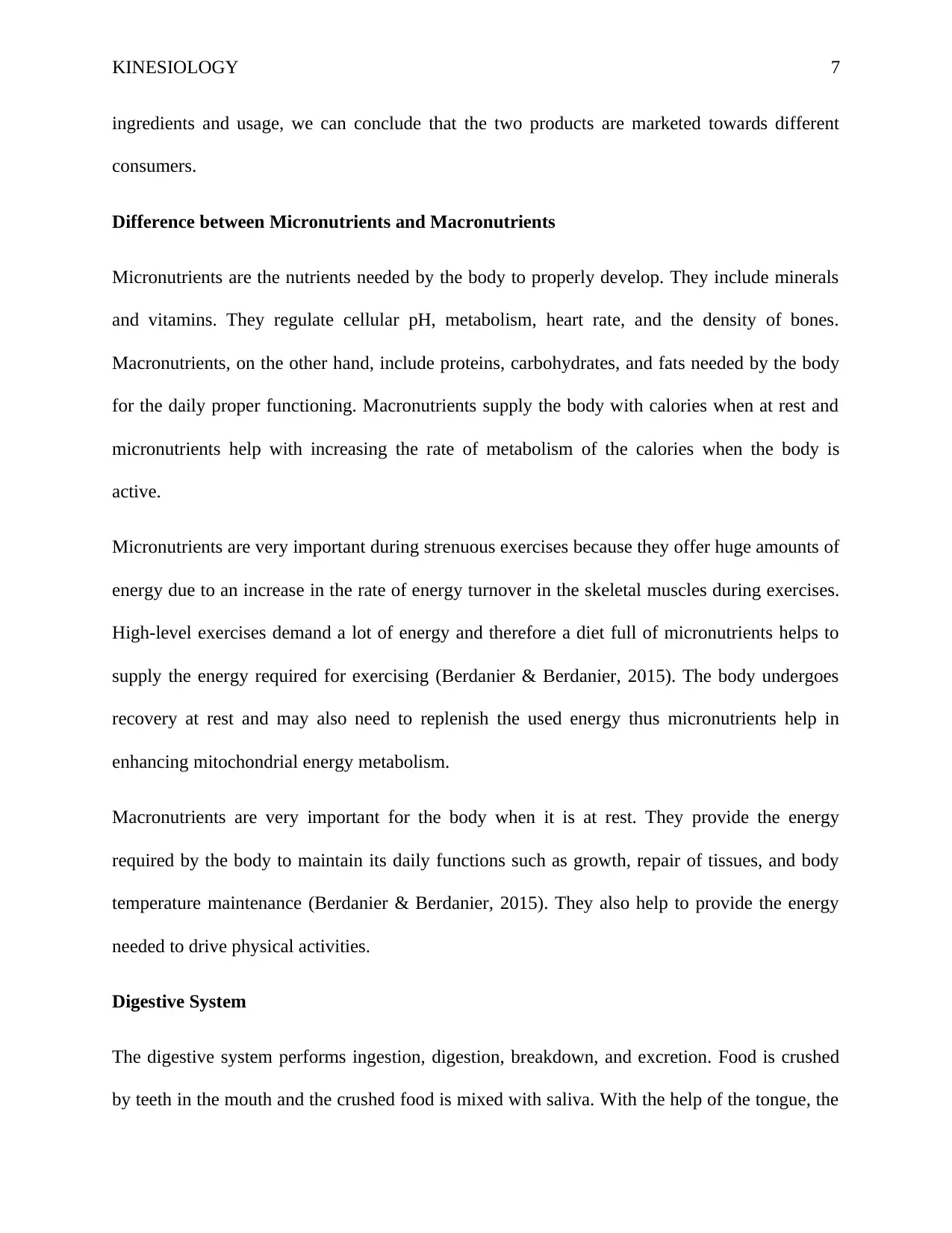
KINESIOLOGY 7
ingredients and usage, we can conclude that the two products are marketed towards different
consumers.
Difference between Micronutrients and Macronutrients
Micronutrients are the nutrients needed by the body to properly develop. They include minerals
and vitamins. They regulate cellular pH, metabolism, heart rate, and the density of bones.
Macronutrients, on the other hand, include proteins, carbohydrates, and fats needed by the body
for the daily proper functioning. Macronutrients supply the body with calories when at rest and
micronutrients help with increasing the rate of metabolism of the calories when the body is
active.
Micronutrients are very important during strenuous exercises because they offer huge amounts of
energy due to an increase in the rate of energy turnover in the skeletal muscles during exercises.
High-level exercises demand a lot of energy and therefore a diet full of micronutrients helps to
supply the energy required for exercising (Berdanier & Berdanier, 2015). The body undergoes
recovery at rest and may also need to replenish the used energy thus micronutrients help in
enhancing mitochondrial energy metabolism.
Macronutrients are very important for the body when it is at rest. They provide the energy
required by the body to maintain its daily functions such as growth, repair of tissues, and body
temperature maintenance (Berdanier & Berdanier, 2015). They also help to provide the energy
needed to drive physical activities.
Digestive System
The digestive system performs ingestion, digestion, breakdown, and excretion. Food is crushed
by teeth in the mouth and the crushed food is mixed with saliva. With the help of the tongue, the
ingredients and usage, we can conclude that the two products are marketed towards different
consumers.
Difference between Micronutrients and Macronutrients
Micronutrients are the nutrients needed by the body to properly develop. They include minerals
and vitamins. They regulate cellular pH, metabolism, heart rate, and the density of bones.
Macronutrients, on the other hand, include proteins, carbohydrates, and fats needed by the body
for the daily proper functioning. Macronutrients supply the body with calories when at rest and
micronutrients help with increasing the rate of metabolism of the calories when the body is
active.
Micronutrients are very important during strenuous exercises because they offer huge amounts of
energy due to an increase in the rate of energy turnover in the skeletal muscles during exercises.
High-level exercises demand a lot of energy and therefore a diet full of micronutrients helps to
supply the energy required for exercising (Berdanier & Berdanier, 2015). The body undergoes
recovery at rest and may also need to replenish the used energy thus micronutrients help in
enhancing mitochondrial energy metabolism.
Macronutrients are very important for the body when it is at rest. They provide the energy
required by the body to maintain its daily functions such as growth, repair of tissues, and body
temperature maintenance (Berdanier & Berdanier, 2015). They also help to provide the energy
needed to drive physical activities.
Digestive System
The digestive system performs ingestion, digestion, breakdown, and excretion. Food is crushed
by teeth in the mouth and the crushed food is mixed with saliva. With the help of the tongue, the
Paraphrase This Document
Need a fresh take? Get an instant paraphrase of this document with our AI Paraphraser
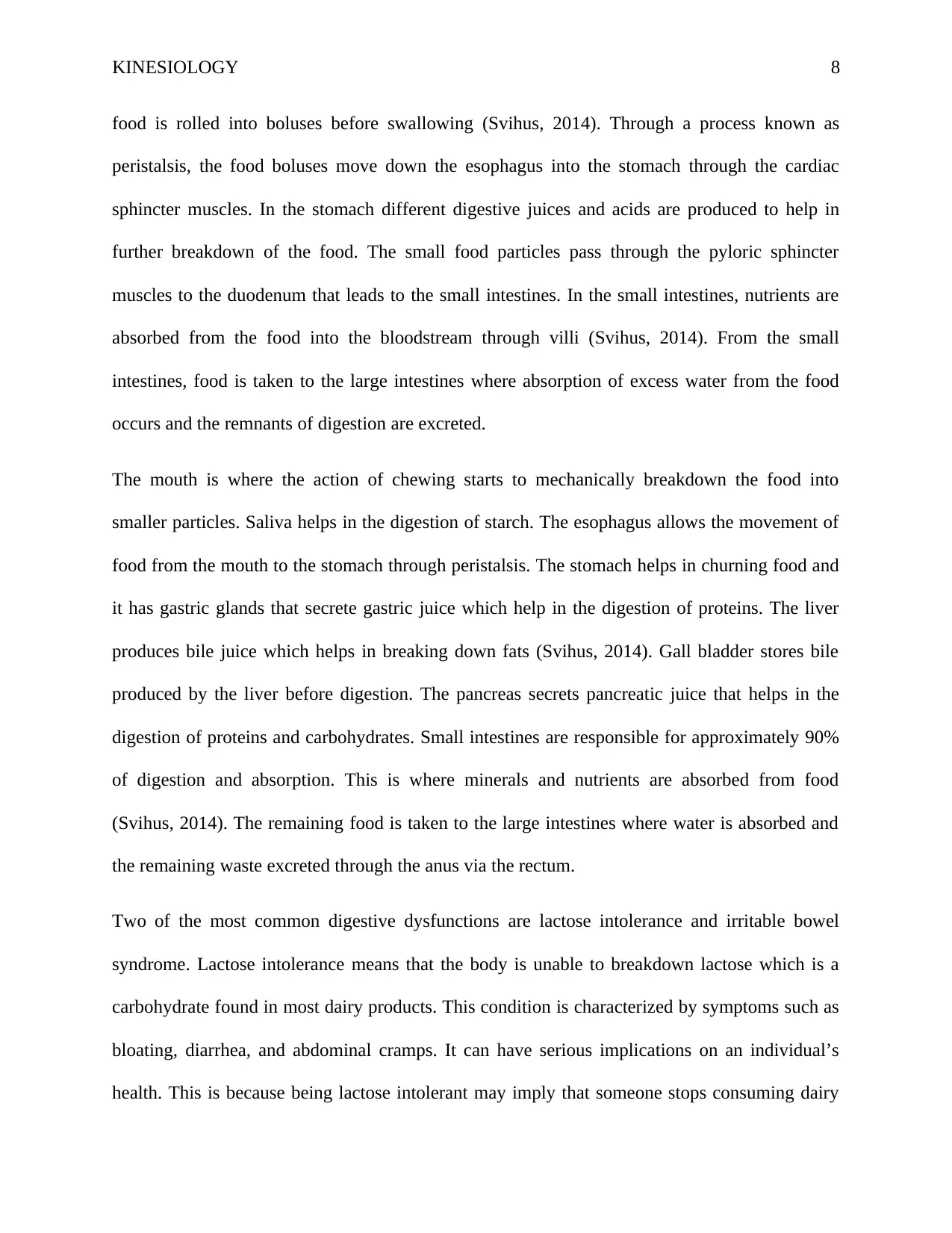
KINESIOLOGY 8
food is rolled into boluses before swallowing (Svihus, 2014). Through a process known as
peristalsis, the food boluses move down the esophagus into the stomach through the cardiac
sphincter muscles. In the stomach different digestive juices and acids are produced to help in
further breakdown of the food. The small food particles pass through the pyloric sphincter
muscles to the duodenum that leads to the small intestines. In the small intestines, nutrients are
absorbed from the food into the bloodstream through villi (Svihus, 2014). From the small
intestines, food is taken to the large intestines where absorption of excess water from the food
occurs and the remnants of digestion are excreted.
The mouth is where the action of chewing starts to mechanically breakdown the food into
smaller particles. Saliva helps in the digestion of starch. The esophagus allows the movement of
food from the mouth to the stomach through peristalsis. The stomach helps in churning food and
it has gastric glands that secrete gastric juice which help in the digestion of proteins. The liver
produces bile juice which helps in breaking down fats (Svihus, 2014). Gall bladder stores bile
produced by the liver before digestion. The pancreas secrets pancreatic juice that helps in the
digestion of proteins and carbohydrates. Small intestines are responsible for approximately 90%
of digestion and absorption. This is where minerals and nutrients are absorbed from food
(Svihus, 2014). The remaining food is taken to the large intestines where water is absorbed and
the remaining waste excreted through the anus via the rectum.
Two of the most common digestive dysfunctions are lactose intolerance and irritable bowel
syndrome. Lactose intolerance means that the body is unable to breakdown lactose which is a
carbohydrate found in most dairy products. This condition is characterized by symptoms such as
bloating, diarrhea, and abdominal cramps. It can have serious implications on an individual’s
health. This is because being lactose intolerant may imply that someone stops consuming dairy
food is rolled into boluses before swallowing (Svihus, 2014). Through a process known as
peristalsis, the food boluses move down the esophagus into the stomach through the cardiac
sphincter muscles. In the stomach different digestive juices and acids are produced to help in
further breakdown of the food. The small food particles pass through the pyloric sphincter
muscles to the duodenum that leads to the small intestines. In the small intestines, nutrients are
absorbed from the food into the bloodstream through villi (Svihus, 2014). From the small
intestines, food is taken to the large intestines where absorption of excess water from the food
occurs and the remnants of digestion are excreted.
The mouth is where the action of chewing starts to mechanically breakdown the food into
smaller particles. Saliva helps in the digestion of starch. The esophagus allows the movement of
food from the mouth to the stomach through peristalsis. The stomach helps in churning food and
it has gastric glands that secrete gastric juice which help in the digestion of proteins. The liver
produces bile juice which helps in breaking down fats (Svihus, 2014). Gall bladder stores bile
produced by the liver before digestion. The pancreas secrets pancreatic juice that helps in the
digestion of proteins and carbohydrates. Small intestines are responsible for approximately 90%
of digestion and absorption. This is where minerals and nutrients are absorbed from food
(Svihus, 2014). The remaining food is taken to the large intestines where water is absorbed and
the remaining waste excreted through the anus via the rectum.
Two of the most common digestive dysfunctions are lactose intolerance and irritable bowel
syndrome. Lactose intolerance means that the body is unable to breakdown lactose which is a
carbohydrate found in most dairy products. This condition is characterized by symptoms such as
bloating, diarrhea, and abdominal cramps. It can have serious implications on an individual’s
health. This is because being lactose intolerant may imply that someone stops consuming dairy
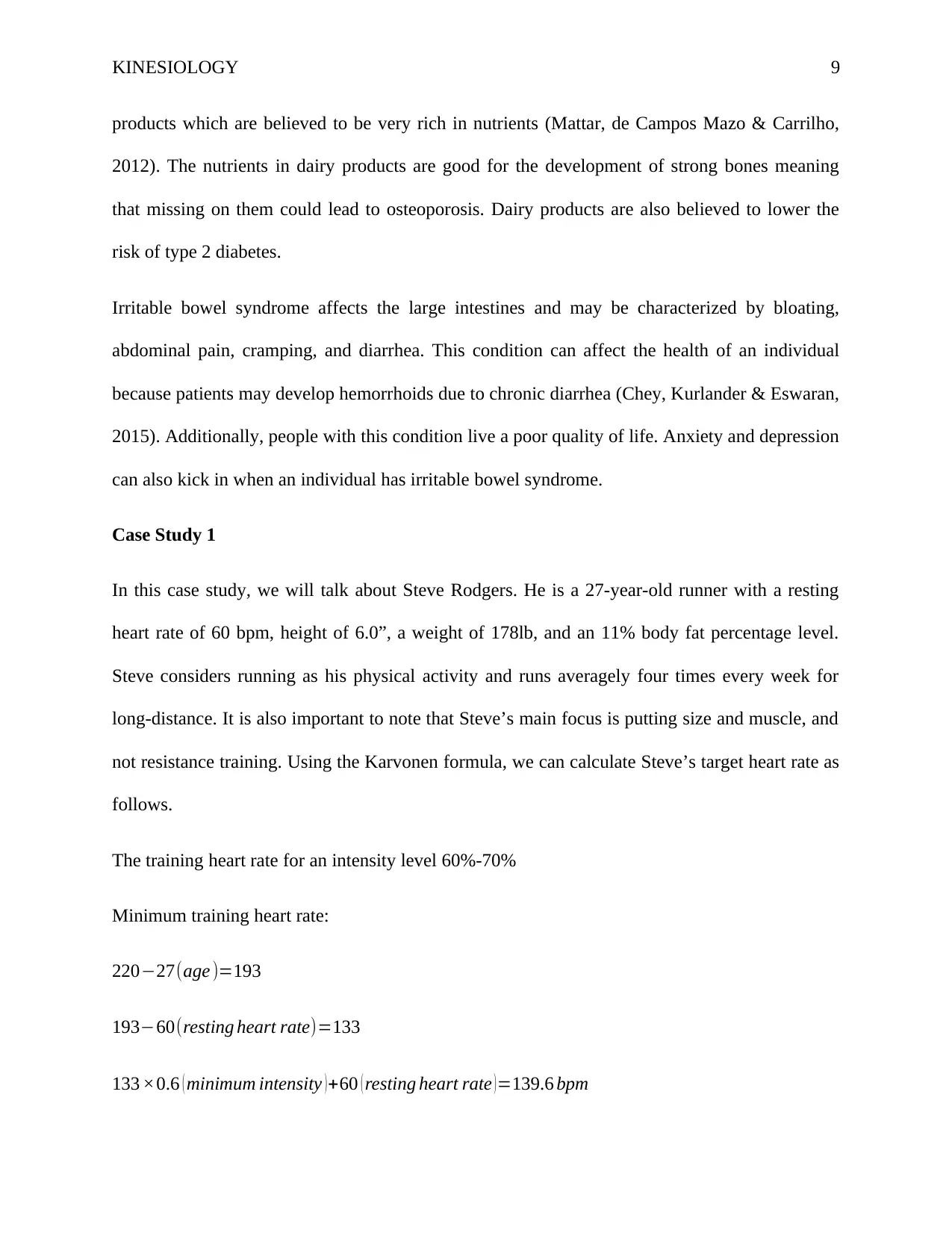
KINESIOLOGY 9
products which are believed to be very rich in nutrients (Mattar, de Campos Mazo & Carrilho,
2012). The nutrients in dairy products are good for the development of strong bones meaning
that missing on them could lead to osteoporosis. Dairy products are also believed to lower the
risk of type 2 diabetes.
Irritable bowel syndrome affects the large intestines and may be characterized by bloating,
abdominal pain, cramping, and diarrhea. This condition can affect the health of an individual
because patients may develop hemorrhoids due to chronic diarrhea (Chey, Kurlander & Eswaran,
2015). Additionally, people with this condition live a poor quality of life. Anxiety and depression
can also kick in when an individual has irritable bowel syndrome.
Case Study 1
In this case study, we will talk about Steve Rodgers. He is a 27-year-old runner with a resting
heart rate of 60 bpm, height of 6.0”, a weight of 178lb, and an 11% body fat percentage level.
Steve considers running as his physical activity and runs averagely four times every week for
long-distance. It is also important to note that Steve’s main focus is putting size and muscle, and
not resistance training. Using the Karvonen formula, we can calculate Steve’s target heart rate as
follows.
The training heart rate for an intensity level 60%-70%
Minimum training heart rate:
220−27(age )=193
193−60(resting heart rate)=133
133 ×0.6 ( minimum intensity )+60 ( resting heart rate )=139.6 bpm
products which are believed to be very rich in nutrients (Mattar, de Campos Mazo & Carrilho,
2012). The nutrients in dairy products are good for the development of strong bones meaning
that missing on them could lead to osteoporosis. Dairy products are also believed to lower the
risk of type 2 diabetes.
Irritable bowel syndrome affects the large intestines and may be characterized by bloating,
abdominal pain, cramping, and diarrhea. This condition can affect the health of an individual
because patients may develop hemorrhoids due to chronic diarrhea (Chey, Kurlander & Eswaran,
2015). Additionally, people with this condition live a poor quality of life. Anxiety and depression
can also kick in when an individual has irritable bowel syndrome.
Case Study 1
In this case study, we will talk about Steve Rodgers. He is a 27-year-old runner with a resting
heart rate of 60 bpm, height of 6.0”, a weight of 178lb, and an 11% body fat percentage level.
Steve considers running as his physical activity and runs averagely four times every week for
long-distance. It is also important to note that Steve’s main focus is putting size and muscle, and
not resistance training. Using the Karvonen formula, we can calculate Steve’s target heart rate as
follows.
The training heart rate for an intensity level 60%-70%
Minimum training heart rate:
220−27(age )=193
193−60(resting heart rate)=133
133 ×0.6 ( minimum intensity )+60 ( resting heart rate )=139.6 bpm
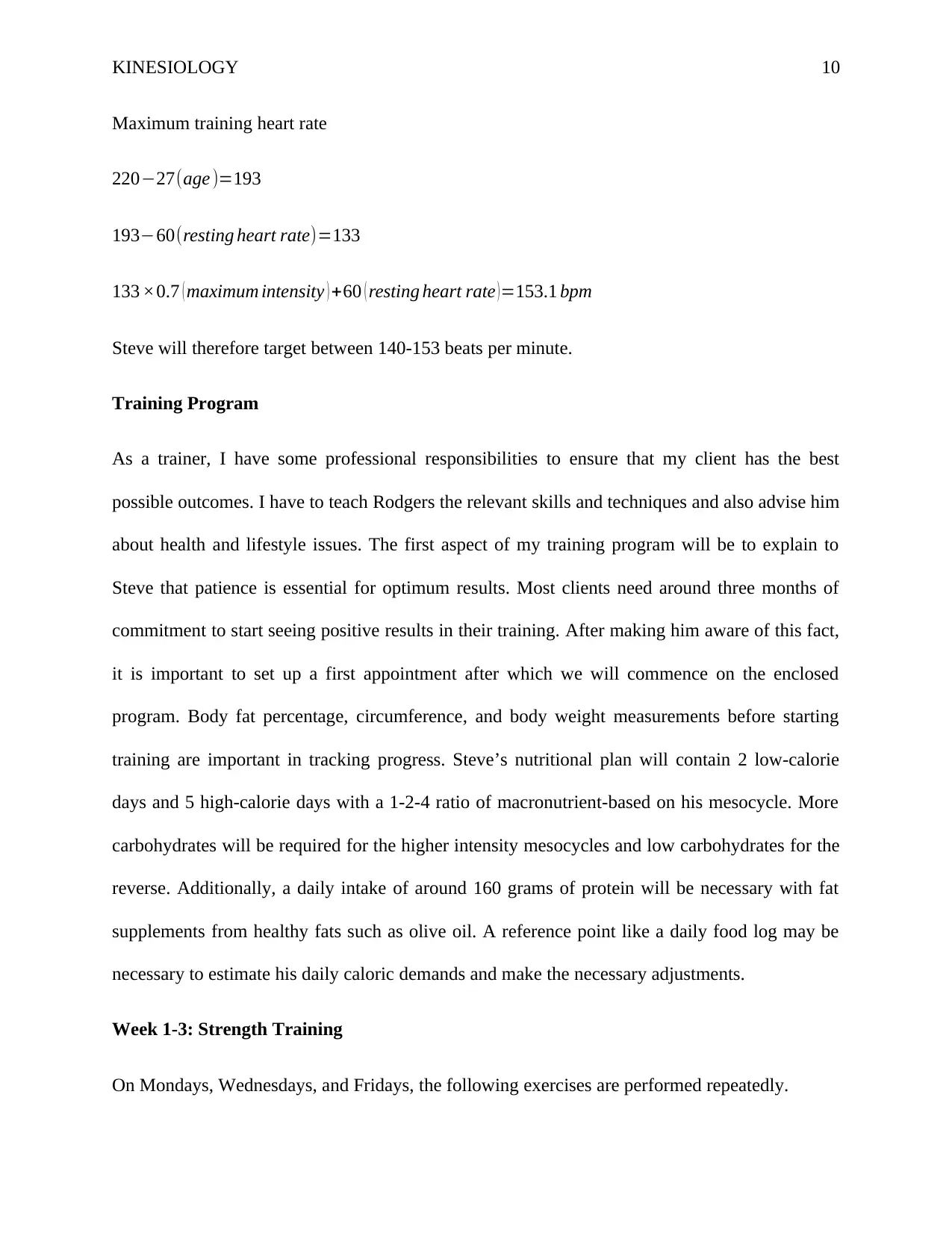
KINESIOLOGY 10
Maximum training heart rate
220−27(age )=193
193−60(resting heart rate)=133
133 ×0.7 ( maximum intensity ) +60 ( resting heart rate )=153.1 bpm
Steve will therefore target between 140-153 beats per minute.
Training Program
As a trainer, I have some professional responsibilities to ensure that my client has the best
possible outcomes. I have to teach Rodgers the relevant skills and techniques and also advise him
about health and lifestyle issues. The first aspect of my training program will be to explain to
Steve that patience is essential for optimum results. Most clients need around three months of
commitment to start seeing positive results in their training. After making him aware of this fact,
it is important to set up a first appointment after which we will commence on the enclosed
program. Body fat percentage, circumference, and body weight measurements before starting
training are important in tracking progress. Steve’s nutritional plan will contain 2 low-calorie
days and 5 high-calorie days with a 1-2-4 ratio of macronutrient-based on his mesocycle. More
carbohydrates will be required for the higher intensity mesocycles and low carbohydrates for the
reverse. Additionally, a daily intake of around 160 grams of protein will be necessary with fat
supplements from healthy fats such as olive oil. A reference point like a daily food log may be
necessary to estimate his daily caloric demands and make the necessary adjustments.
Week 1-3: Strength Training
On Mondays, Wednesdays, and Fridays, the following exercises are performed repeatedly.
Maximum training heart rate
220−27(age )=193
193−60(resting heart rate)=133
133 ×0.7 ( maximum intensity ) +60 ( resting heart rate )=153.1 bpm
Steve will therefore target between 140-153 beats per minute.
Training Program
As a trainer, I have some professional responsibilities to ensure that my client has the best
possible outcomes. I have to teach Rodgers the relevant skills and techniques and also advise him
about health and lifestyle issues. The first aspect of my training program will be to explain to
Steve that patience is essential for optimum results. Most clients need around three months of
commitment to start seeing positive results in their training. After making him aware of this fact,
it is important to set up a first appointment after which we will commence on the enclosed
program. Body fat percentage, circumference, and body weight measurements before starting
training are important in tracking progress. Steve’s nutritional plan will contain 2 low-calorie
days and 5 high-calorie days with a 1-2-4 ratio of macronutrient-based on his mesocycle. More
carbohydrates will be required for the higher intensity mesocycles and low carbohydrates for the
reverse. Additionally, a daily intake of around 160 grams of protein will be necessary with fat
supplements from healthy fats such as olive oil. A reference point like a daily food log may be
necessary to estimate his daily caloric demands and make the necessary adjustments.
Week 1-3: Strength Training
On Mondays, Wednesdays, and Fridays, the following exercises are performed repeatedly.
Secure Best Marks with AI Grader
Need help grading? Try our AI Grader for instant feedback on your assignments.
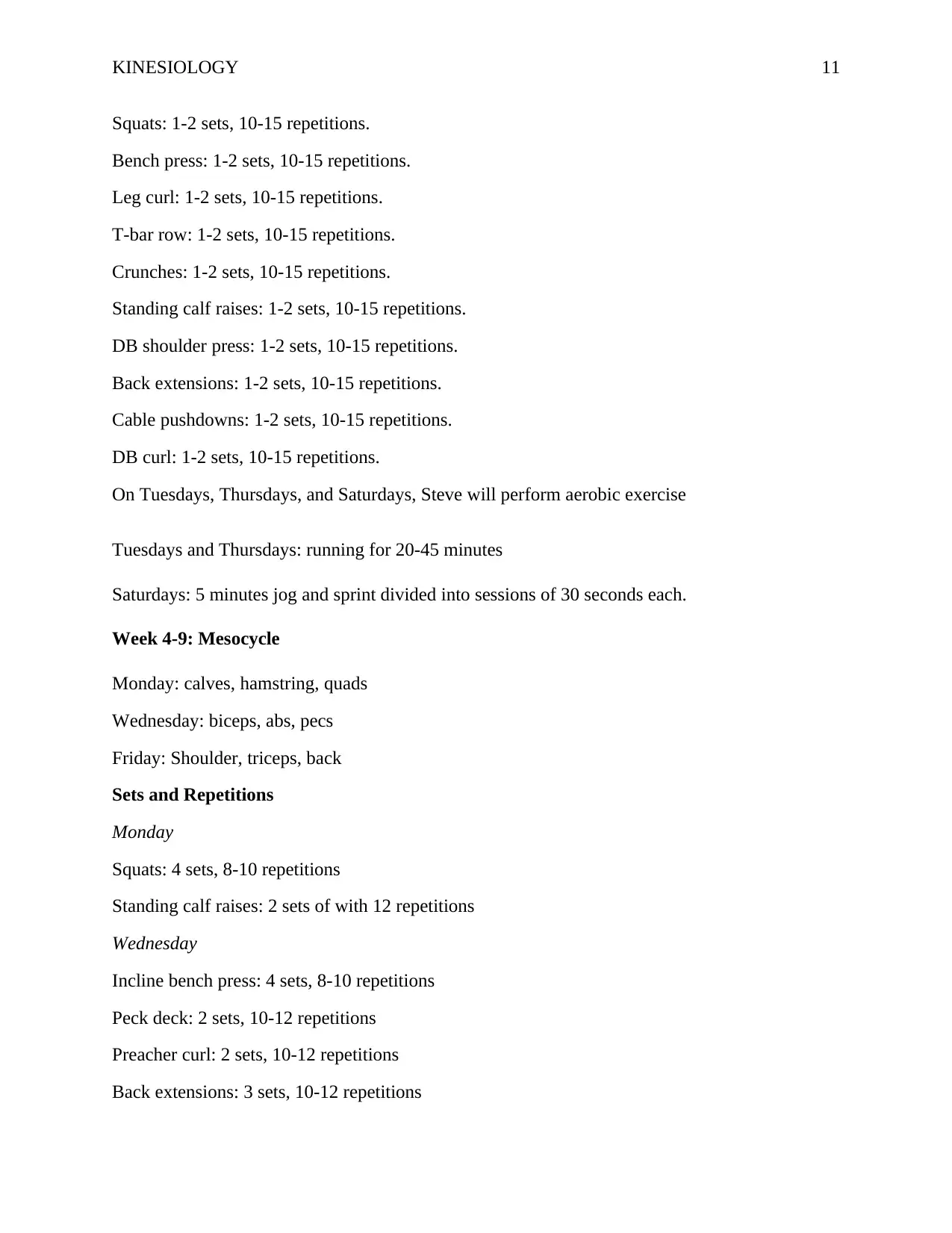
KINESIOLOGY 11
Squats: 1-2 sets, 10-15 repetitions.
Bench press: 1-2 sets, 10-15 repetitions.
Leg curl: 1-2 sets, 10-15 repetitions.
T-bar row: 1-2 sets, 10-15 repetitions.
Crunches: 1-2 sets, 10-15 repetitions.
Standing calf raises: 1-2 sets, 10-15 repetitions.
DB shoulder press: 1-2 sets, 10-15 repetitions.
Back extensions: 1-2 sets, 10-15 repetitions.
Cable pushdowns: 1-2 sets, 10-15 repetitions.
DB curl: 1-2 sets, 10-15 repetitions.
On Tuesdays, Thursdays, and Saturdays, Steve will perform aerobic exercise
Tuesdays and Thursdays: running for 20-45 minutes
Saturdays: 5 minutes jog and sprint divided into sessions of 30 seconds each.
Week 4-9: Mesocycle
Monday: calves, hamstring, quads
Wednesday: biceps, abs, pecs
Friday: Shoulder, triceps, back
Sets and Repetitions
Monday
Squats: 4 sets, 8-10 repetitions
Standing calf raises: 2 sets of with 12 repetitions
Wednesday
Incline bench press: 4 sets, 8-10 repetitions
Peck deck: 2 sets, 10-12 repetitions
Preacher curl: 2 sets, 10-12 repetitions
Back extensions: 3 sets, 10-12 repetitions
Squats: 1-2 sets, 10-15 repetitions.
Bench press: 1-2 sets, 10-15 repetitions.
Leg curl: 1-2 sets, 10-15 repetitions.
T-bar row: 1-2 sets, 10-15 repetitions.
Crunches: 1-2 sets, 10-15 repetitions.
Standing calf raises: 1-2 sets, 10-15 repetitions.
DB shoulder press: 1-2 sets, 10-15 repetitions.
Back extensions: 1-2 sets, 10-15 repetitions.
Cable pushdowns: 1-2 sets, 10-15 repetitions.
DB curl: 1-2 sets, 10-15 repetitions.
On Tuesdays, Thursdays, and Saturdays, Steve will perform aerobic exercise
Tuesdays and Thursdays: running for 20-45 minutes
Saturdays: 5 minutes jog and sprint divided into sessions of 30 seconds each.
Week 4-9: Mesocycle
Monday: calves, hamstring, quads
Wednesday: biceps, abs, pecs
Friday: Shoulder, triceps, back
Sets and Repetitions
Monday
Squats: 4 sets, 8-10 repetitions
Standing calf raises: 2 sets of with 12 repetitions
Wednesday
Incline bench press: 4 sets, 8-10 repetitions
Peck deck: 2 sets, 10-12 repetitions
Preacher curl: 2 sets, 10-12 repetitions
Back extensions: 3 sets, 10-12 repetitions
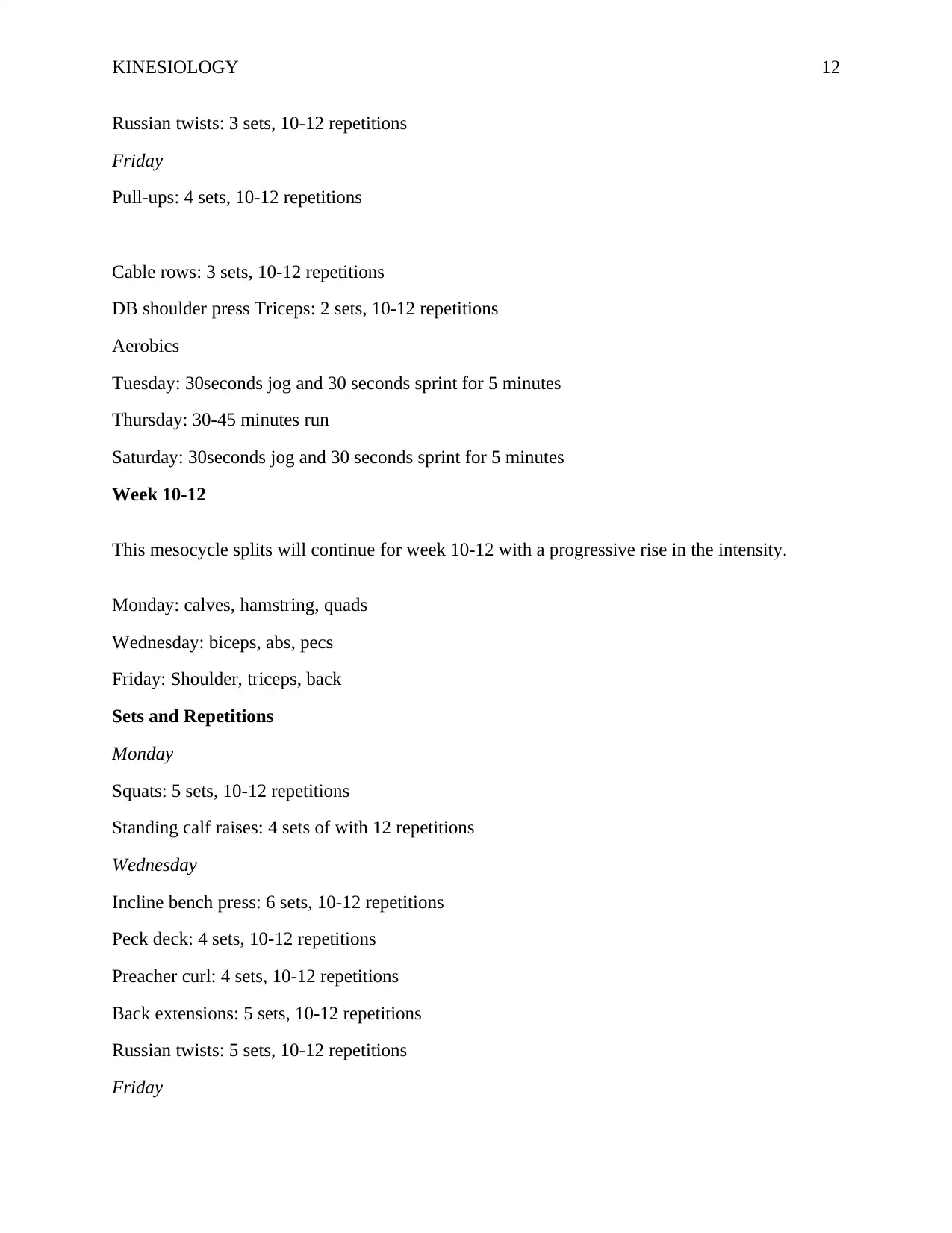
KINESIOLOGY 12
Russian twists: 3 sets, 10-12 repetitions
Friday
Pull-ups: 4 sets, 10-12 repetitions
Cable rows: 3 sets, 10-12 repetitions
DB shoulder press Triceps: 2 sets, 10-12 repetitions
Aerobics
Tuesday: 30seconds jog and 30 seconds sprint for 5 minutes
Thursday: 30-45 minutes run
Saturday: 30seconds jog and 30 seconds sprint for 5 minutes
Week 10-12
This mesocycle splits will continue for week 10-12 with a progressive rise in the intensity.
Monday: calves, hamstring, quads
Wednesday: biceps, abs, pecs
Friday: Shoulder, triceps, back
Sets and Repetitions
Monday
Squats: 5 sets, 10-12 repetitions
Standing calf raises: 4 sets of with 12 repetitions
Wednesday
Incline bench press: 6 sets, 10-12 repetitions
Peck deck: 4 sets, 10-12 repetitions
Preacher curl: 4 sets, 10-12 repetitions
Back extensions: 5 sets, 10-12 repetitions
Russian twists: 5 sets, 10-12 repetitions
Friday
Russian twists: 3 sets, 10-12 repetitions
Friday
Pull-ups: 4 sets, 10-12 repetitions
Cable rows: 3 sets, 10-12 repetitions
DB shoulder press Triceps: 2 sets, 10-12 repetitions
Aerobics
Tuesday: 30seconds jog and 30 seconds sprint for 5 minutes
Thursday: 30-45 minutes run
Saturday: 30seconds jog and 30 seconds sprint for 5 minutes
Week 10-12
This mesocycle splits will continue for week 10-12 with a progressive rise in the intensity.
Monday: calves, hamstring, quads
Wednesday: biceps, abs, pecs
Friday: Shoulder, triceps, back
Sets and Repetitions
Monday
Squats: 5 sets, 10-12 repetitions
Standing calf raises: 4 sets of with 12 repetitions
Wednesday
Incline bench press: 6 sets, 10-12 repetitions
Peck deck: 4 sets, 10-12 repetitions
Preacher curl: 4 sets, 10-12 repetitions
Back extensions: 5 sets, 10-12 repetitions
Russian twists: 5 sets, 10-12 repetitions
Friday
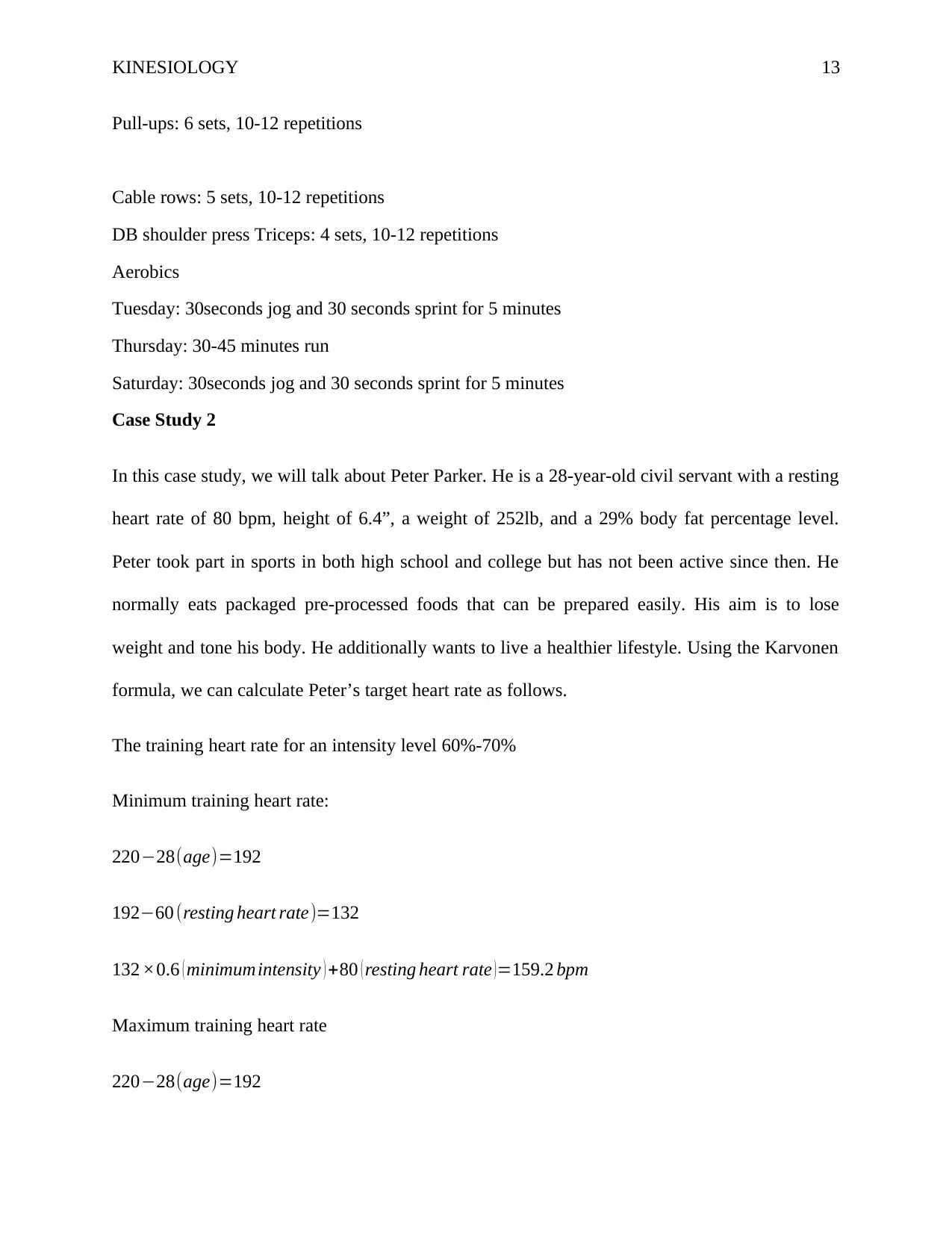
KINESIOLOGY 13
Pull-ups: 6 sets, 10-12 repetitions
Cable rows: 5 sets, 10-12 repetitions
DB shoulder press Triceps: 4 sets, 10-12 repetitions
Aerobics
Tuesday: 30seconds jog and 30 seconds sprint for 5 minutes
Thursday: 30-45 minutes run
Saturday: 30seconds jog and 30 seconds sprint for 5 minutes
Case Study 2
In this case study, we will talk about Peter Parker. He is a 28-year-old civil servant with a resting
heart rate of 80 bpm, height of 6.4”, a weight of 252lb, and a 29% body fat percentage level.
Peter took part in sports in both high school and college but has not been active since then. He
normally eats packaged pre-processed foods that can be prepared easily. His aim is to lose
weight and tone his body. He additionally wants to live a healthier lifestyle. Using the Karvonen
formula, we can calculate Peter’s target heart rate as follows.
The training heart rate for an intensity level 60%-70%
Minimum training heart rate:
220−28(age)=192
192−60 (resting heart rate)=132
132 ×0.6 ( minimum intensity ) +80 ( resting heart rate )=159.2 bpm
Maximum training heart rate
220−28(age)=192
Pull-ups: 6 sets, 10-12 repetitions
Cable rows: 5 sets, 10-12 repetitions
DB shoulder press Triceps: 4 sets, 10-12 repetitions
Aerobics
Tuesday: 30seconds jog and 30 seconds sprint for 5 minutes
Thursday: 30-45 minutes run
Saturday: 30seconds jog and 30 seconds sprint for 5 minutes
Case Study 2
In this case study, we will talk about Peter Parker. He is a 28-year-old civil servant with a resting
heart rate of 80 bpm, height of 6.4”, a weight of 252lb, and a 29% body fat percentage level.
Peter took part in sports in both high school and college but has not been active since then. He
normally eats packaged pre-processed foods that can be prepared easily. His aim is to lose
weight and tone his body. He additionally wants to live a healthier lifestyle. Using the Karvonen
formula, we can calculate Peter’s target heart rate as follows.
The training heart rate for an intensity level 60%-70%
Minimum training heart rate:
220−28(age)=192
192−60 (resting heart rate)=132
132 ×0.6 ( minimum intensity ) +80 ( resting heart rate )=159.2 bpm
Maximum training heart rate
220−28(age)=192
Paraphrase This Document
Need a fresh take? Get an instant paraphrase of this document with our AI Paraphraser
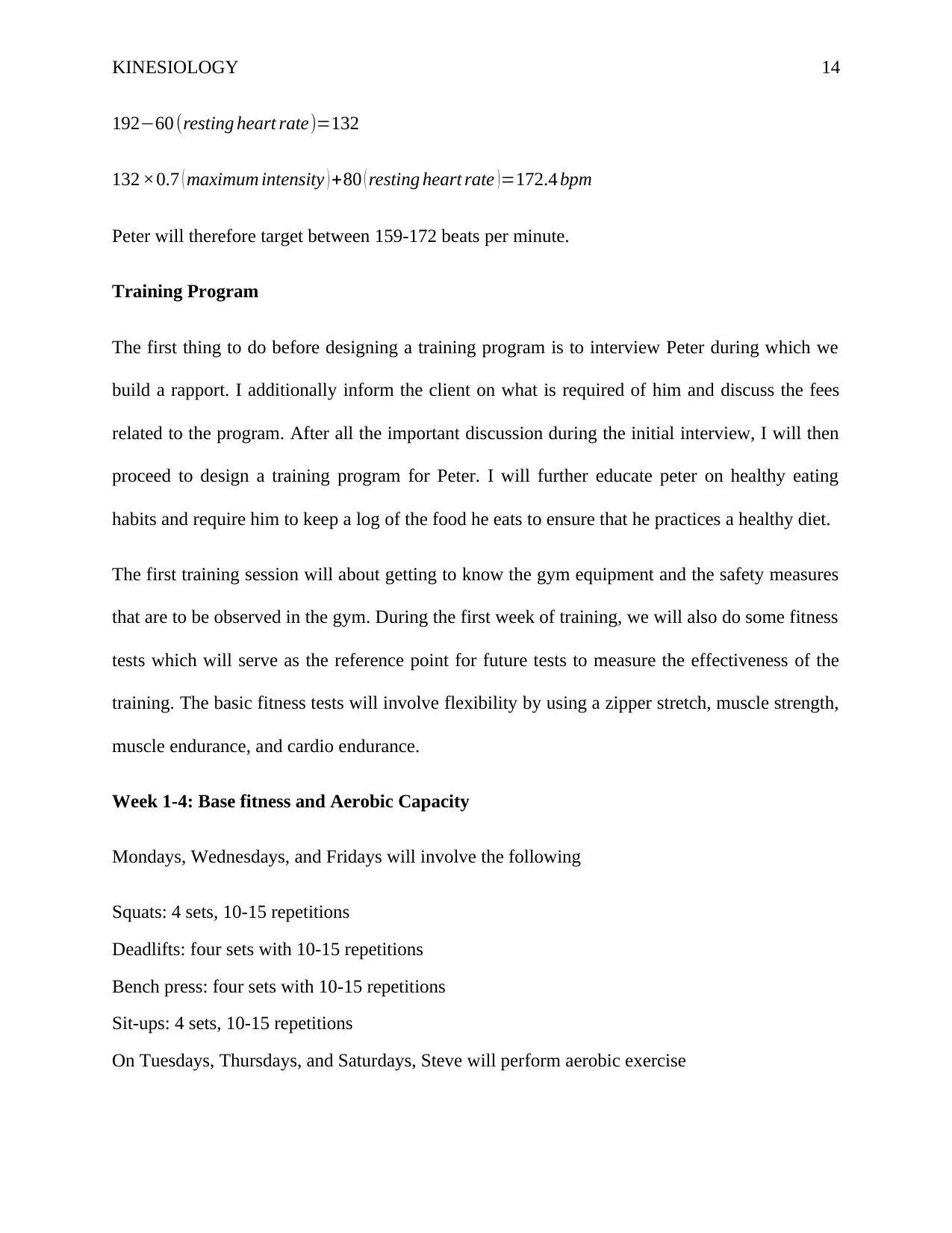
KINESIOLOGY 14
192−60 (resting heart rate)=132
132 ×0.7 ( maximum intensity ) +80 ( resting heart rate ) =172.4 bpm
Peter will therefore target between 159-172 beats per minute.
Training Program
The first thing to do before designing a training program is to interview Peter during which we
build a rapport. I additionally inform the client on what is required of him and discuss the fees
related to the program. After all the important discussion during the initial interview, I will then
proceed to design a training program for Peter. I will further educate peter on healthy eating
habits and require him to keep a log of the food he eats to ensure that he practices a healthy diet.
The first training session will about getting to know the gym equipment and the safety measures
that are to be observed in the gym. During the first week of training, we will also do some fitness
tests which will serve as the reference point for future tests to measure the effectiveness of the
training. The basic fitness tests will involve flexibility by using a zipper stretch, muscle strength,
muscle endurance, and cardio endurance.
Week 1-4: Base fitness and Aerobic Capacity
Mondays, Wednesdays, and Fridays will involve the following
Squats: 4 sets, 10-15 repetitions
Deadlifts: four sets with 10-15 repetitions
Bench press: four sets with 10-15 repetitions
Sit-ups: 4 sets, 10-15 repetitions
On Tuesdays, Thursdays, and Saturdays, Steve will perform aerobic exercise
192−60 (resting heart rate)=132
132 ×0.7 ( maximum intensity ) +80 ( resting heart rate ) =172.4 bpm
Peter will therefore target between 159-172 beats per minute.
Training Program
The first thing to do before designing a training program is to interview Peter during which we
build a rapport. I additionally inform the client on what is required of him and discuss the fees
related to the program. After all the important discussion during the initial interview, I will then
proceed to design a training program for Peter. I will further educate peter on healthy eating
habits and require him to keep a log of the food he eats to ensure that he practices a healthy diet.
The first training session will about getting to know the gym equipment and the safety measures
that are to be observed in the gym. During the first week of training, we will also do some fitness
tests which will serve as the reference point for future tests to measure the effectiveness of the
training. The basic fitness tests will involve flexibility by using a zipper stretch, muscle strength,
muscle endurance, and cardio endurance.
Week 1-4: Base fitness and Aerobic Capacity
Mondays, Wednesdays, and Fridays will involve the following
Squats: 4 sets, 10-15 repetitions
Deadlifts: four sets with 10-15 repetitions
Bench press: four sets with 10-15 repetitions
Sit-ups: 4 sets, 10-15 repetitions
On Tuesdays, Thursdays, and Saturdays, Steve will perform aerobic exercise
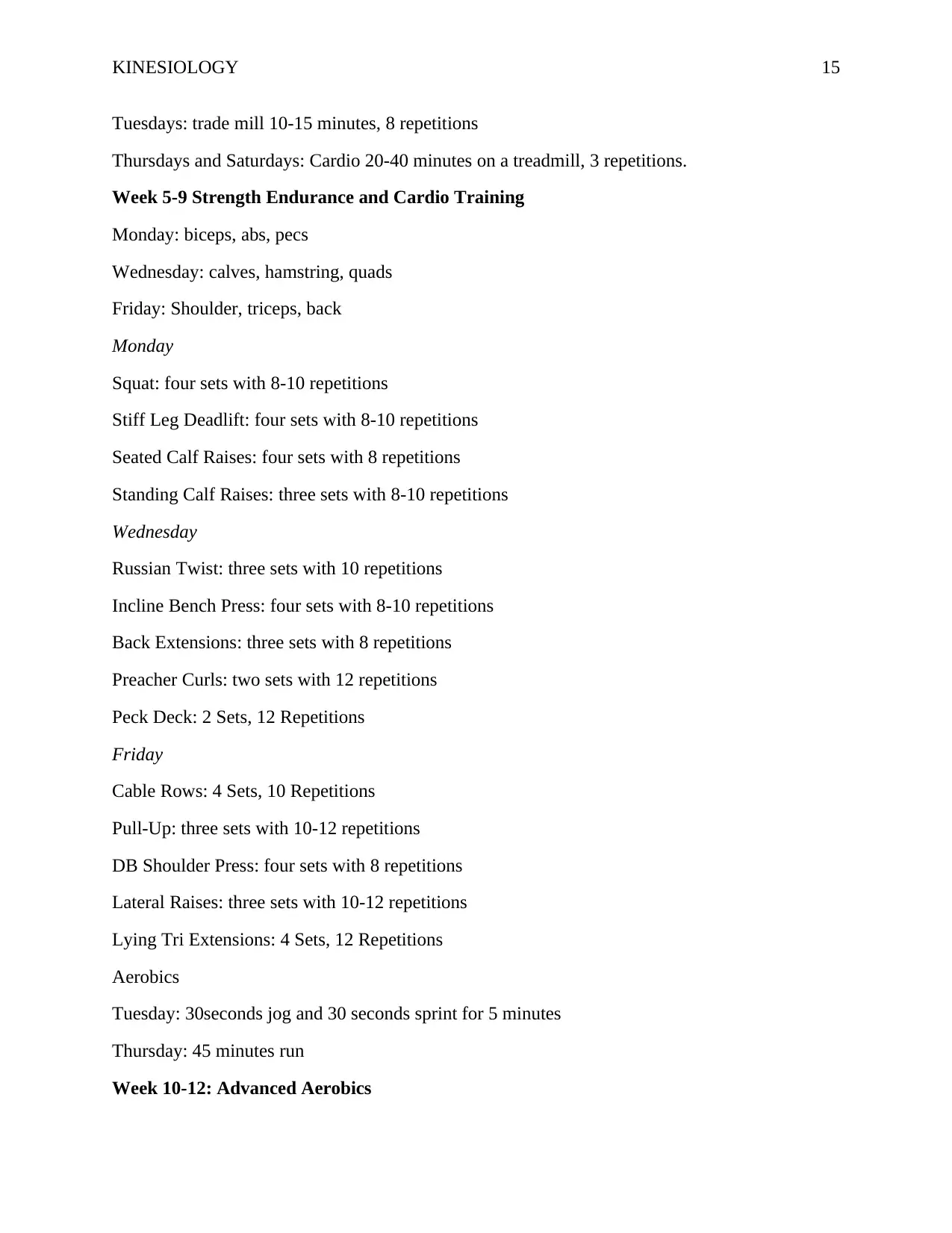
KINESIOLOGY 15
Tuesdays: trade mill 10-15 minutes, 8 repetitions
Thursdays and Saturdays: Cardio 20-40 minutes on a treadmill, 3 repetitions.
Week 5-9 Strength Endurance and Cardio Training
Monday: biceps, abs, pecs
Wednesday: calves, hamstring, quads
Friday: Shoulder, triceps, back
Monday
Squat: four sets with 8-10 repetitions
Stiff Leg Deadlift: four sets with 8-10 repetitions
Seated Calf Raises: four sets with 8 repetitions
Standing Calf Raises: three sets with 8-10 repetitions
Wednesday
Russian Twist: three sets with 10 repetitions
Incline Bench Press: four sets with 8-10 repetitions
Back Extensions: three sets with 8 repetitions
Preacher Curls: two sets with 12 repetitions
Peck Deck: 2 Sets, 12 Repetitions
Friday
Cable Rows: 4 Sets, 10 Repetitions
Pull-Up: three sets with 10-12 repetitions
DB Shoulder Press: four sets with 8 repetitions
Lateral Raises: three sets with 10-12 repetitions
Lying Tri Extensions: 4 Sets, 12 Repetitions
Aerobics
Tuesday: 30seconds jog and 30 seconds sprint for 5 minutes
Thursday: 45 minutes run
Week 10-12: Advanced Aerobics
Tuesdays: trade mill 10-15 minutes, 8 repetitions
Thursdays and Saturdays: Cardio 20-40 minutes on a treadmill, 3 repetitions.
Week 5-9 Strength Endurance and Cardio Training
Monday: biceps, abs, pecs
Wednesday: calves, hamstring, quads
Friday: Shoulder, triceps, back
Monday
Squat: four sets with 8-10 repetitions
Stiff Leg Deadlift: four sets with 8-10 repetitions
Seated Calf Raises: four sets with 8 repetitions
Standing Calf Raises: three sets with 8-10 repetitions
Wednesday
Russian Twist: three sets with 10 repetitions
Incline Bench Press: four sets with 8-10 repetitions
Back Extensions: three sets with 8 repetitions
Preacher Curls: two sets with 12 repetitions
Peck Deck: 2 Sets, 12 Repetitions
Friday
Cable Rows: 4 Sets, 10 Repetitions
Pull-Up: three sets with 10-12 repetitions
DB Shoulder Press: four sets with 8 repetitions
Lateral Raises: three sets with 10-12 repetitions
Lying Tri Extensions: 4 Sets, 12 Repetitions
Aerobics
Tuesday: 30seconds jog and 30 seconds sprint for 5 minutes
Thursday: 45 minutes run
Week 10-12: Advanced Aerobics
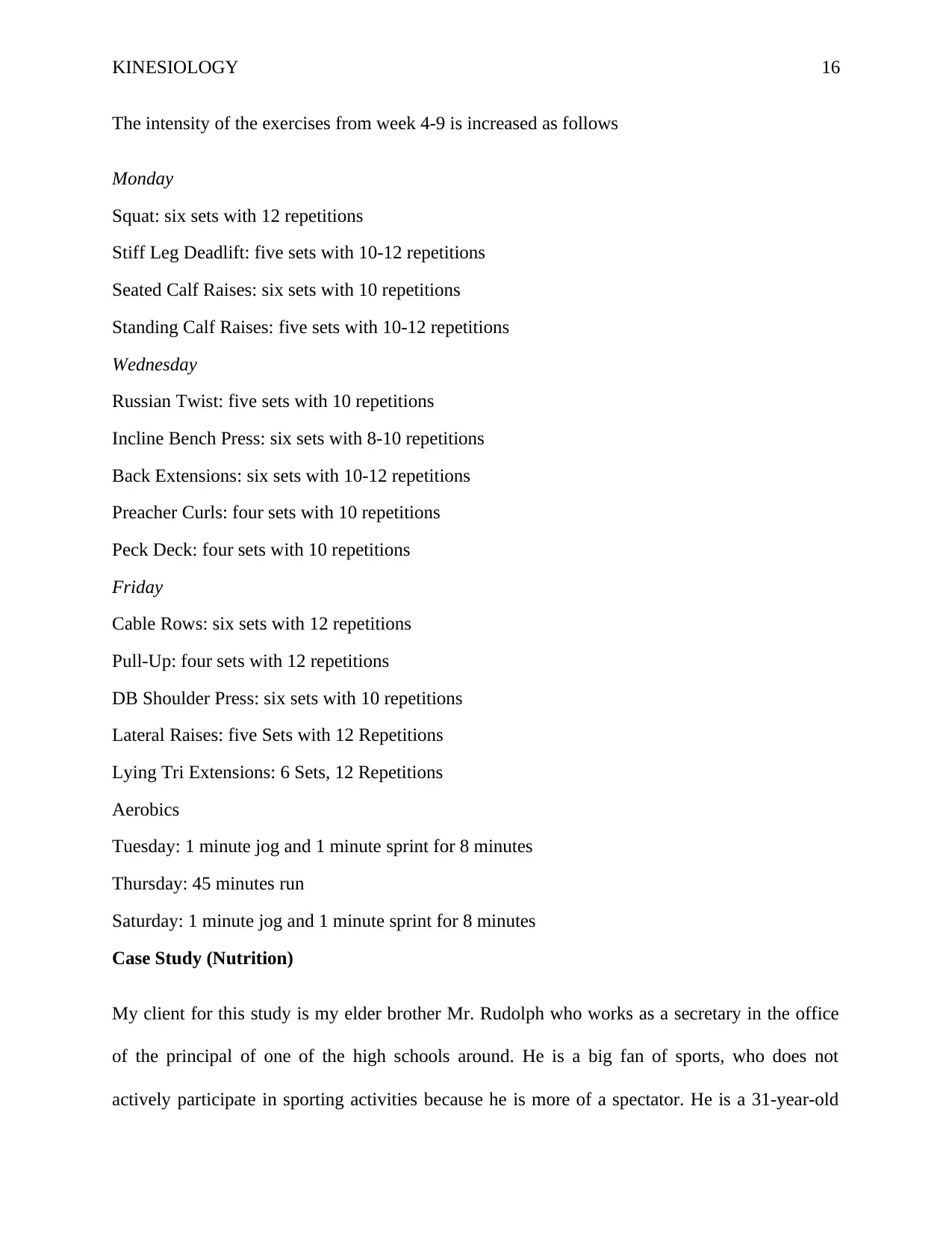
KINESIOLOGY 16
The intensity of the exercises from week 4-9 is increased as follows
Monday
Squat: six sets with 12 repetitions
Stiff Leg Deadlift: five sets with 10-12 repetitions
Seated Calf Raises: six sets with 10 repetitions
Standing Calf Raises: five sets with 10-12 repetitions
Wednesday
Russian Twist: five sets with 10 repetitions
Incline Bench Press: six sets with 8-10 repetitions
Back Extensions: six sets with 10-12 repetitions
Preacher Curls: four sets with 10 repetitions
Peck Deck: four sets with 10 repetitions
Friday
Cable Rows: six sets with 12 repetitions
Pull-Up: four sets with 12 repetitions
DB Shoulder Press: six sets with 10 repetitions
Lateral Raises: five Sets with 12 Repetitions
Lying Tri Extensions: 6 Sets, 12 Repetitions
Aerobics
Tuesday: 1 minute jog and 1 minute sprint for 8 minutes
Thursday: 45 minutes run
Saturday: 1 minute jog and 1 minute sprint for 8 minutes
Case Study (Nutrition)
My client for this study is my elder brother Mr. Rudolph who works as a secretary in the office
of the principal of one of the high schools around. He is a big fan of sports, who does not
actively participate in sporting activities because he is more of a spectator. He is a 31-year-old
The intensity of the exercises from week 4-9 is increased as follows
Monday
Squat: six sets with 12 repetitions
Stiff Leg Deadlift: five sets with 10-12 repetitions
Seated Calf Raises: six sets with 10 repetitions
Standing Calf Raises: five sets with 10-12 repetitions
Wednesday
Russian Twist: five sets with 10 repetitions
Incline Bench Press: six sets with 8-10 repetitions
Back Extensions: six sets with 10-12 repetitions
Preacher Curls: four sets with 10 repetitions
Peck Deck: four sets with 10 repetitions
Friday
Cable Rows: six sets with 12 repetitions
Pull-Up: four sets with 12 repetitions
DB Shoulder Press: six sets with 10 repetitions
Lateral Raises: five Sets with 12 Repetitions
Lying Tri Extensions: 6 Sets, 12 Repetitions
Aerobics
Tuesday: 1 minute jog and 1 minute sprint for 8 minutes
Thursday: 45 minutes run
Saturday: 1 minute jog and 1 minute sprint for 8 minutes
Case Study (Nutrition)
My client for this study is my elder brother Mr. Rudolph who works as a secretary in the office
of the principal of one of the high schools around. He is a big fan of sports, who does not
actively participate in sporting activities because he is more of a spectator. He is a 31-year-old
Secure Best Marks with AI Grader
Need help grading? Try our AI Grader for instant feedback on your assignments.
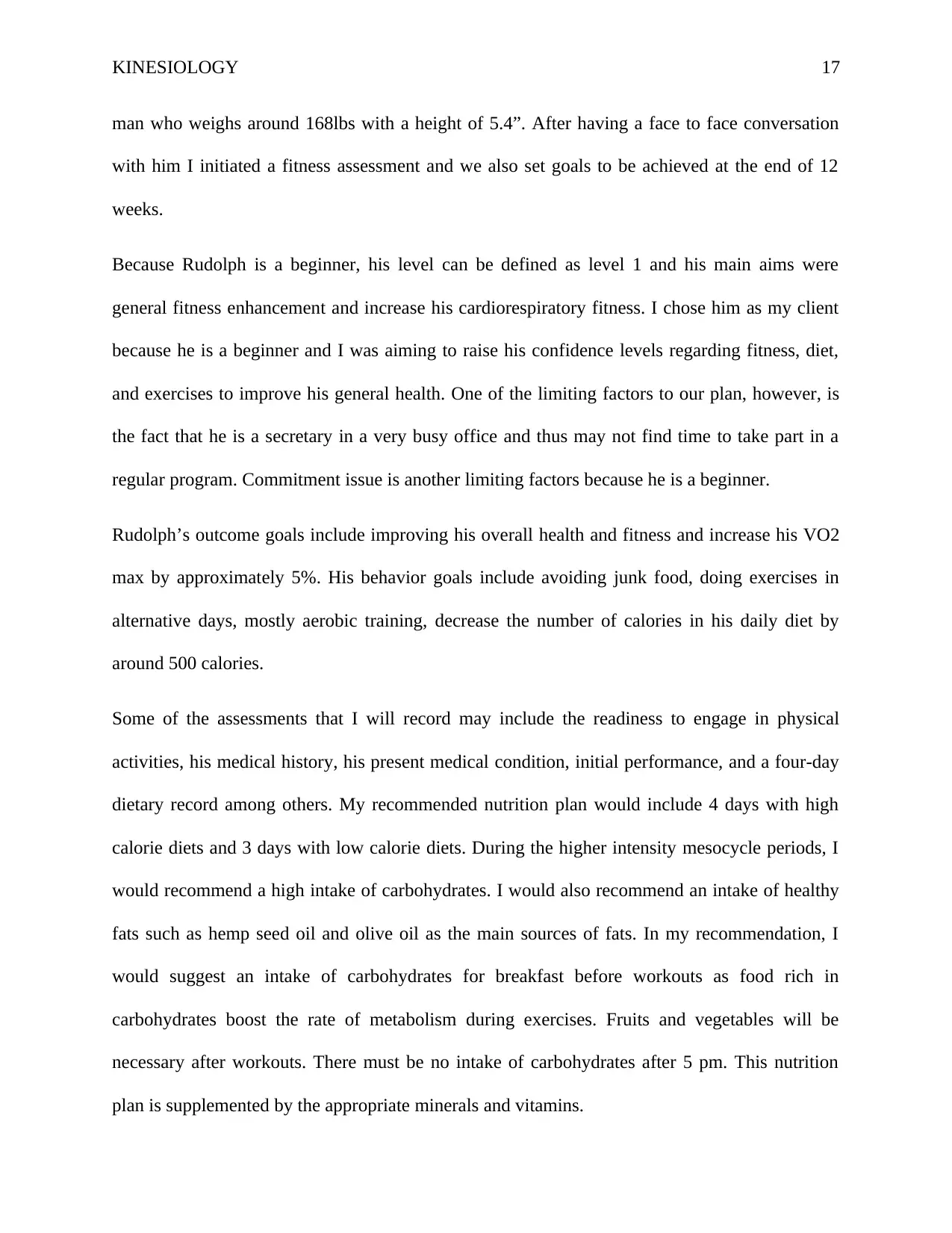
KINESIOLOGY 17
man who weighs around 168lbs with a height of 5.4”. After having a face to face conversation
with him I initiated a fitness assessment and we also set goals to be achieved at the end of 12
weeks.
Because Rudolph is a beginner, his level can be defined as level 1 and his main aims were
general fitness enhancement and increase his cardiorespiratory fitness. I chose him as my client
because he is a beginner and I was aiming to raise his confidence levels regarding fitness, diet,
and exercises to improve his general health. One of the limiting factors to our plan, however, is
the fact that he is a secretary in a very busy office and thus may not find time to take part in a
regular program. Commitment issue is another limiting factors because he is a beginner.
Rudolph’s outcome goals include improving his overall health and fitness and increase his VO2
max by approximately 5%. His behavior goals include avoiding junk food, doing exercises in
alternative days, mostly aerobic training, decrease the number of calories in his daily diet by
around 500 calories.
Some of the assessments that I will record may include the readiness to engage in physical
activities, his medical history, his present medical condition, initial performance, and a four-day
dietary record among others. My recommended nutrition plan would include 4 days with high
calorie diets and 3 days with low calorie diets. During the higher intensity mesocycle periods, I
would recommend a high intake of carbohydrates. I would also recommend an intake of healthy
fats such as hemp seed oil and olive oil as the main sources of fats. In my recommendation, I
would suggest an intake of carbohydrates for breakfast before workouts as food rich in
carbohydrates boost the rate of metabolism during exercises. Fruits and vegetables will be
necessary after workouts. There must be no intake of carbohydrates after 5 pm. This nutrition
plan is supplemented by the appropriate minerals and vitamins.
man who weighs around 168lbs with a height of 5.4”. After having a face to face conversation
with him I initiated a fitness assessment and we also set goals to be achieved at the end of 12
weeks.
Because Rudolph is a beginner, his level can be defined as level 1 and his main aims were
general fitness enhancement and increase his cardiorespiratory fitness. I chose him as my client
because he is a beginner and I was aiming to raise his confidence levels regarding fitness, diet,
and exercises to improve his general health. One of the limiting factors to our plan, however, is
the fact that he is a secretary in a very busy office and thus may not find time to take part in a
regular program. Commitment issue is another limiting factors because he is a beginner.
Rudolph’s outcome goals include improving his overall health and fitness and increase his VO2
max by approximately 5%. His behavior goals include avoiding junk food, doing exercises in
alternative days, mostly aerobic training, decrease the number of calories in his daily diet by
around 500 calories.
Some of the assessments that I will record may include the readiness to engage in physical
activities, his medical history, his present medical condition, initial performance, and a four-day
dietary record among others. My recommended nutrition plan would include 4 days with high
calorie diets and 3 days with low calorie diets. During the higher intensity mesocycle periods, I
would recommend a high intake of carbohydrates. I would also recommend an intake of healthy
fats such as hemp seed oil and olive oil as the main sources of fats. In my recommendation, I
would suggest an intake of carbohydrates for breakfast before workouts as food rich in
carbohydrates boost the rate of metabolism during exercises. Fruits and vegetables will be
necessary after workouts. There must be no intake of carbohydrates after 5 pm. This nutrition
plan is supplemented by the appropriate minerals and vitamins.
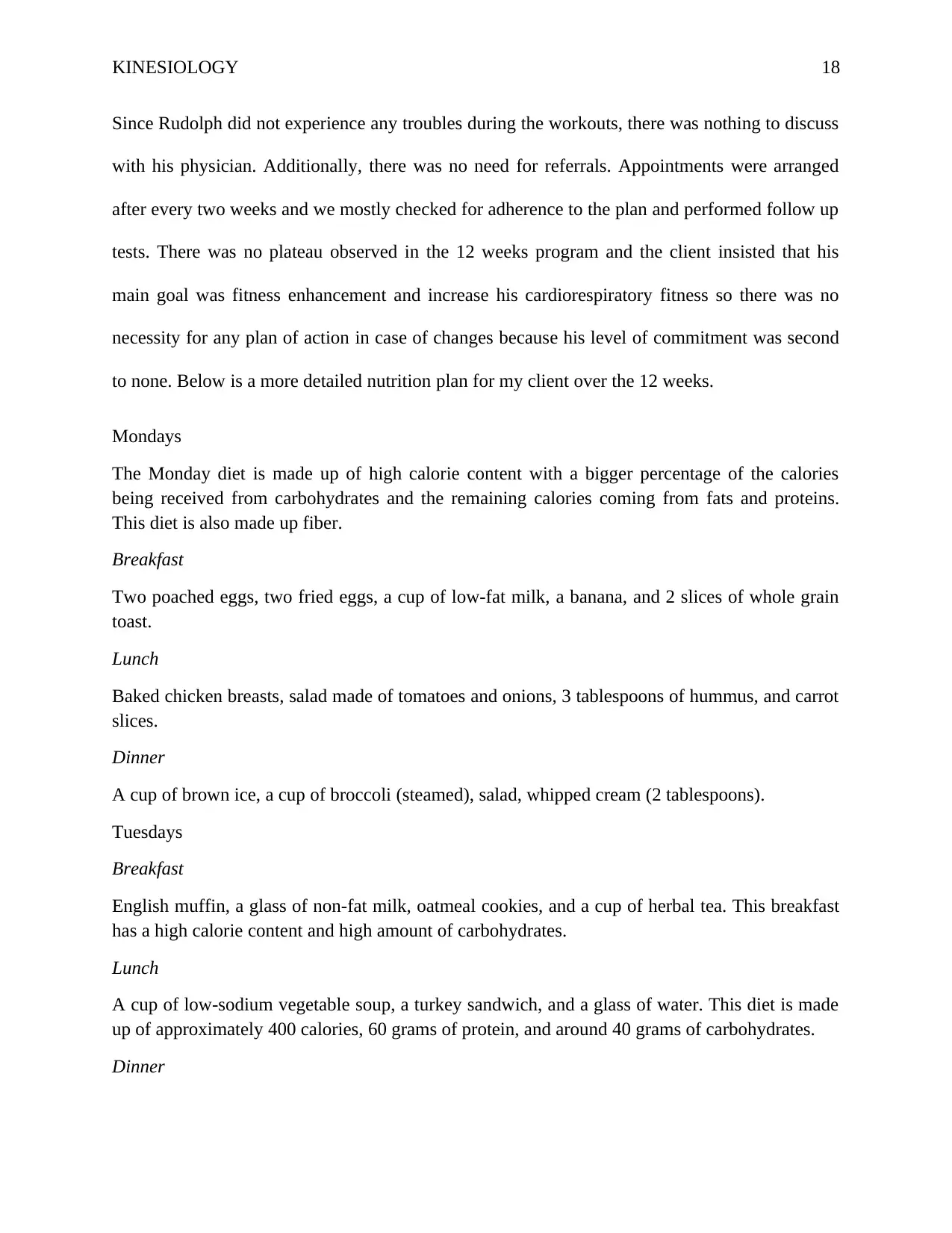
KINESIOLOGY 18
Since Rudolph did not experience any troubles during the workouts, there was nothing to discuss
with his physician. Additionally, there was no need for referrals. Appointments were arranged
after every two weeks and we mostly checked for adherence to the plan and performed follow up
tests. There was no plateau observed in the 12 weeks program and the client insisted that his
main goal was fitness enhancement and increase his cardiorespiratory fitness so there was no
necessity for any plan of action in case of changes because his level of commitment was second
to none. Below is a more detailed nutrition plan for my client over the 12 weeks.
Mondays
The Monday diet is made up of high calorie content with a bigger percentage of the calories
being received from carbohydrates and the remaining calories coming from fats and proteins.
This diet is also made up fiber.
Breakfast
Two poached eggs, two fried eggs, a cup of low-fat milk, a banana, and 2 slices of whole grain
toast.
Lunch
Baked chicken breasts, salad made of tomatoes and onions, 3 tablespoons of hummus, and carrot
slices.
Dinner
A cup of brown ice, a cup of broccoli (steamed), salad, whipped cream (2 tablespoons).
Tuesdays
Breakfast
English muffin, a glass of non-fat milk, oatmeal cookies, and a cup of herbal tea. This breakfast
has a high calorie content and high amount of carbohydrates.
Lunch
A cup of low-sodium vegetable soup, a turkey sandwich, and a glass of water. This diet is made
up of approximately 400 calories, 60 grams of protein, and around 40 grams of carbohydrates.
Dinner
Since Rudolph did not experience any troubles during the workouts, there was nothing to discuss
with his physician. Additionally, there was no need for referrals. Appointments were arranged
after every two weeks and we mostly checked for adherence to the plan and performed follow up
tests. There was no plateau observed in the 12 weeks program and the client insisted that his
main goal was fitness enhancement and increase his cardiorespiratory fitness so there was no
necessity for any plan of action in case of changes because his level of commitment was second
to none. Below is a more detailed nutrition plan for my client over the 12 weeks.
Mondays
The Monday diet is made up of high calorie content with a bigger percentage of the calories
being received from carbohydrates and the remaining calories coming from fats and proteins.
This diet is also made up fiber.
Breakfast
Two poached eggs, two fried eggs, a cup of low-fat milk, a banana, and 2 slices of whole grain
toast.
Lunch
Baked chicken breasts, salad made of tomatoes and onions, 3 tablespoons of hummus, and carrot
slices.
Dinner
A cup of brown ice, a cup of broccoli (steamed), salad, whipped cream (2 tablespoons).
Tuesdays
Breakfast
English muffin, a glass of non-fat milk, oatmeal cookies, and a cup of herbal tea. This breakfast
has a high calorie content and high amount of carbohydrates.
Lunch
A cup of low-sodium vegetable soup, a turkey sandwich, and a glass of water. This diet is made
up of approximately 400 calories, 60 grams of protein, and around 40 grams of carbohydrates.
Dinner
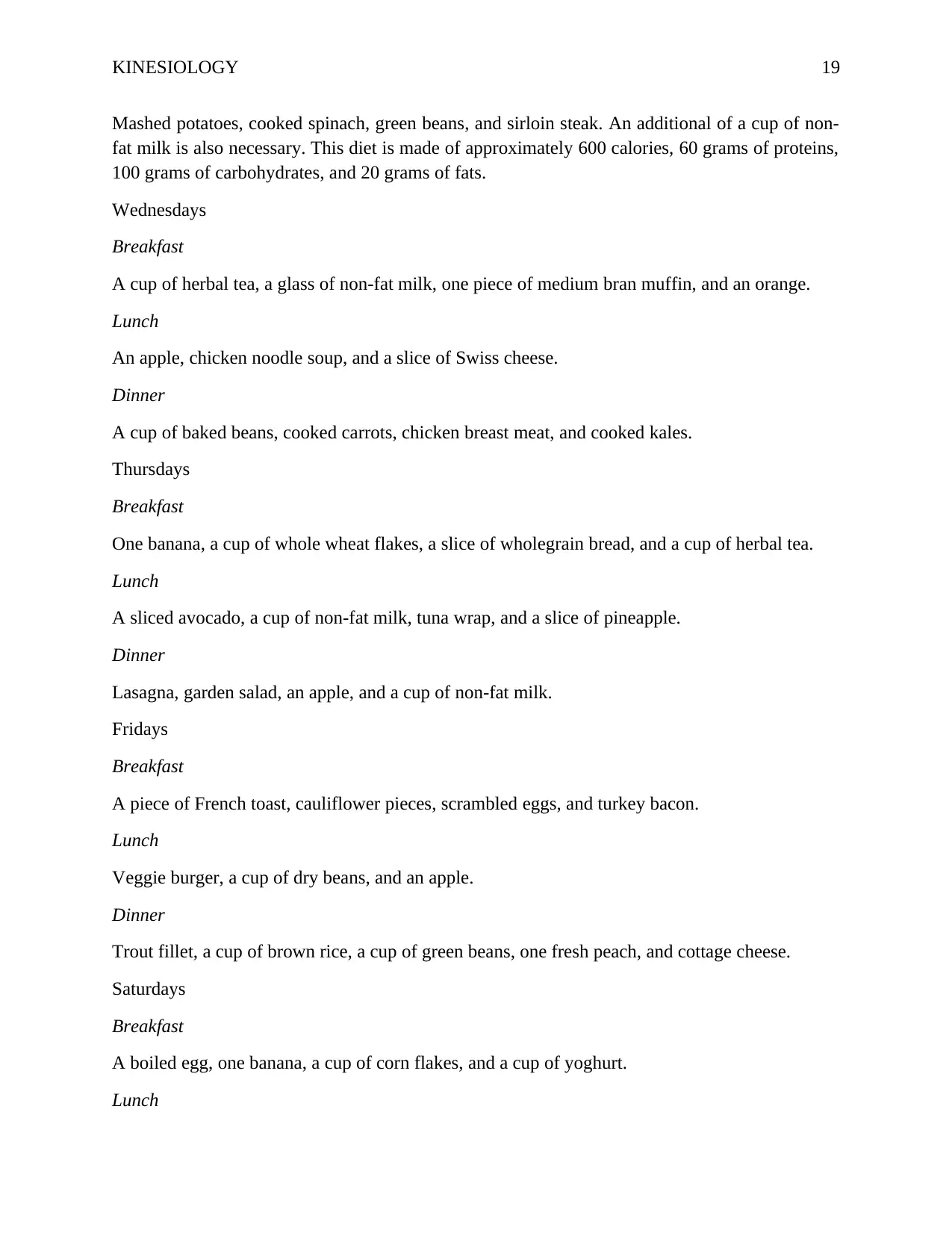
KINESIOLOGY 19
Mashed potatoes, cooked spinach, green beans, and sirloin steak. An additional of a cup of non-
fat milk is also necessary. This diet is made of approximately 600 calories, 60 grams of proteins,
100 grams of carbohydrates, and 20 grams of fats.
Wednesdays
Breakfast
A cup of herbal tea, a glass of non-fat milk, one piece of medium bran muffin, and an orange.
Lunch
An apple, chicken noodle soup, and a slice of Swiss cheese.
Dinner
A cup of baked beans, cooked carrots, chicken breast meat, and cooked kales.
Thursdays
Breakfast
One banana, a cup of whole wheat flakes, a slice of wholegrain bread, and a cup of herbal tea.
Lunch
A sliced avocado, a cup of non-fat milk, tuna wrap, and a slice of pineapple.
Dinner
Lasagna, garden salad, an apple, and a cup of non-fat milk.
Fridays
Breakfast
A piece of French toast, cauliflower pieces, scrambled eggs, and turkey bacon.
Lunch
Veggie burger, a cup of dry beans, and an apple.
Dinner
Trout fillet, a cup of brown rice, a cup of green beans, one fresh peach, and cottage cheese.
Saturdays
Breakfast
A boiled egg, one banana, a cup of corn flakes, and a cup of yoghurt.
Lunch
Mashed potatoes, cooked spinach, green beans, and sirloin steak. An additional of a cup of non-
fat milk is also necessary. This diet is made of approximately 600 calories, 60 grams of proteins,
100 grams of carbohydrates, and 20 grams of fats.
Wednesdays
Breakfast
A cup of herbal tea, a glass of non-fat milk, one piece of medium bran muffin, and an orange.
Lunch
An apple, chicken noodle soup, and a slice of Swiss cheese.
Dinner
A cup of baked beans, cooked carrots, chicken breast meat, and cooked kales.
Thursdays
Breakfast
One banana, a cup of whole wheat flakes, a slice of wholegrain bread, and a cup of herbal tea.
Lunch
A sliced avocado, a cup of non-fat milk, tuna wrap, and a slice of pineapple.
Dinner
Lasagna, garden salad, an apple, and a cup of non-fat milk.
Fridays
Breakfast
A piece of French toast, cauliflower pieces, scrambled eggs, and turkey bacon.
Lunch
Veggie burger, a cup of dry beans, and an apple.
Dinner
Trout fillet, a cup of brown rice, a cup of green beans, one fresh peach, and cottage cheese.
Saturdays
Breakfast
A boiled egg, one banana, a cup of corn flakes, and a cup of yoghurt.
Lunch
Paraphrase This Document
Need a fresh take? Get an instant paraphrase of this document with our AI Paraphraser
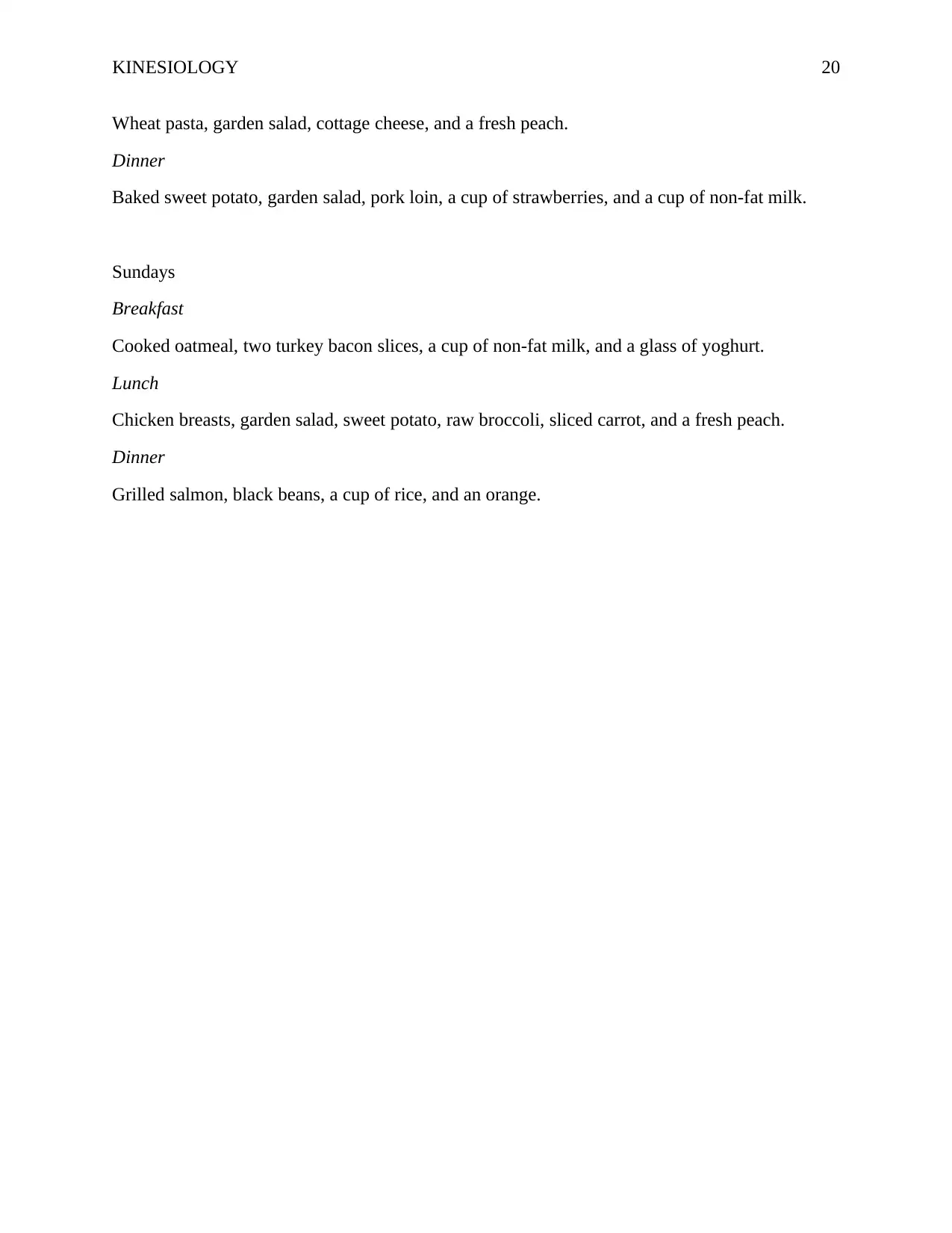
KINESIOLOGY 20
Wheat pasta, garden salad, cottage cheese, and a fresh peach.
Dinner
Baked sweet potato, garden salad, pork loin, a cup of strawberries, and a cup of non-fat milk.
Sundays
Breakfast
Cooked oatmeal, two turkey bacon slices, a cup of non-fat milk, and a glass of yoghurt.
Lunch
Chicken breasts, garden salad, sweet potato, raw broccoli, sliced carrot, and a fresh peach.
Dinner
Grilled salmon, black beans, a cup of rice, and an orange.
Wheat pasta, garden salad, cottage cheese, and a fresh peach.
Dinner
Baked sweet potato, garden salad, pork loin, a cup of strawberries, and a cup of non-fat milk.
Sundays
Breakfast
Cooked oatmeal, two turkey bacon slices, a cup of non-fat milk, and a glass of yoghurt.
Lunch
Chicken breasts, garden salad, sweet potato, raw broccoli, sliced carrot, and a fresh peach.
Dinner
Grilled salmon, black beans, a cup of rice, and an orange.
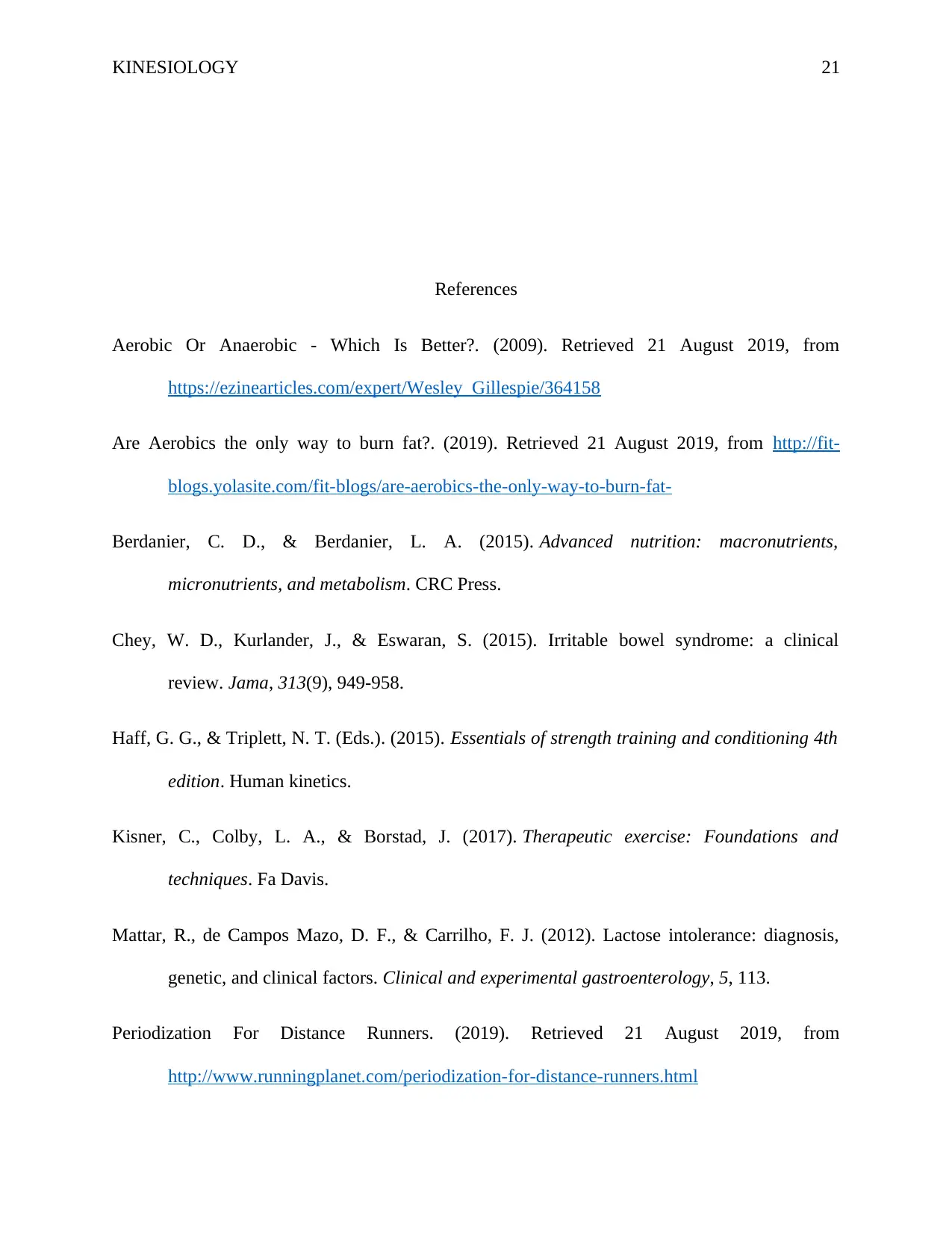
KINESIOLOGY 21
References
Aerobic Or Anaerobic - Which Is Better?. (2009). Retrieved 21 August 2019, from
https://ezinearticles.com/expert/Wesley_Gillespie/364158
Are Aerobics the only way to burn fat?. (2019). Retrieved 21 August 2019, from http://fit-
blogs.yolasite.com/fit-blogs/are-aerobics-the-only-way-to-burn-fat-
Berdanier, C. D., & Berdanier, L. A. (2015). Advanced nutrition: macronutrients,
micronutrients, and metabolism. CRC Press.
Chey, W. D., Kurlander, J., & Eswaran, S. (2015). Irritable bowel syndrome: a clinical
review. Jama, 313(9), 949-958.
Haff, G. G., & Triplett, N. T. (Eds.). (2015). Essentials of strength training and conditioning 4th
edition. Human kinetics.
Kisner, C., Colby, L. A., & Borstad, J. (2017). Therapeutic exercise: Foundations and
techniques. Fa Davis.
Mattar, R., de Campos Mazo, D. F., & Carrilho, F. J. (2012). Lactose intolerance: diagnosis,
genetic, and clinical factors. Clinical and experimental gastroenterology, 5, 113.
Periodization For Distance Runners. (2019). Retrieved 21 August 2019, from
http://www.runningplanet.com/periodization-for-distance-runners.html
References
Aerobic Or Anaerobic - Which Is Better?. (2009). Retrieved 21 August 2019, from
https://ezinearticles.com/expert/Wesley_Gillespie/364158
Are Aerobics the only way to burn fat?. (2019). Retrieved 21 August 2019, from http://fit-
blogs.yolasite.com/fit-blogs/are-aerobics-the-only-way-to-burn-fat-
Berdanier, C. D., & Berdanier, L. A. (2015). Advanced nutrition: macronutrients,
micronutrients, and metabolism. CRC Press.
Chey, W. D., Kurlander, J., & Eswaran, S. (2015). Irritable bowel syndrome: a clinical
review. Jama, 313(9), 949-958.
Haff, G. G., & Triplett, N. T. (Eds.). (2015). Essentials of strength training and conditioning 4th
edition. Human kinetics.
Kisner, C., Colby, L. A., & Borstad, J. (2017). Therapeutic exercise: Foundations and
techniques. Fa Davis.
Mattar, R., de Campos Mazo, D. F., & Carrilho, F. J. (2012). Lactose intolerance: diagnosis,
genetic, and clinical factors. Clinical and experimental gastroenterology, 5, 113.
Periodization For Distance Runners. (2019). Retrieved 21 August 2019, from
http://www.runningplanet.com/periodization-for-distance-runners.html
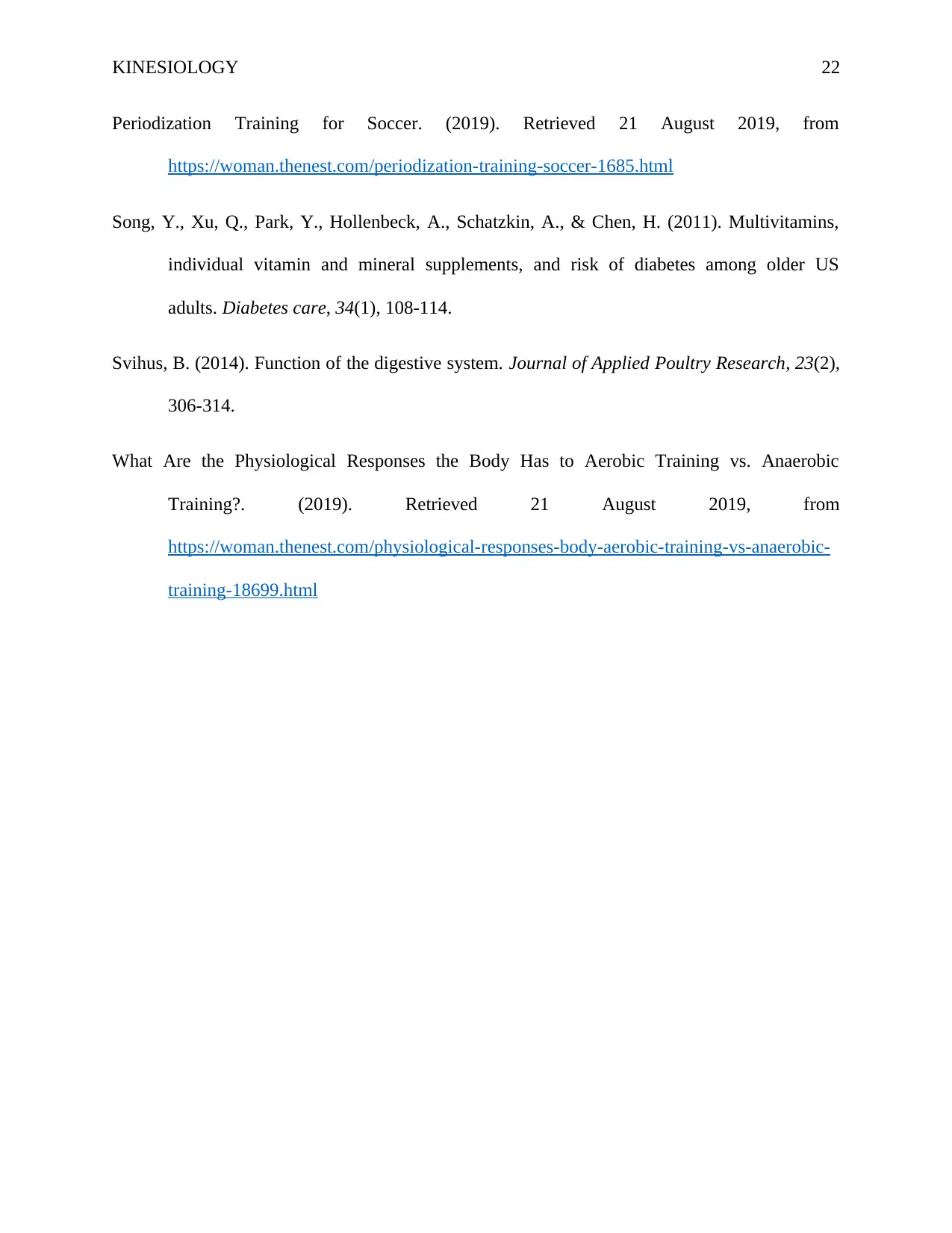
KINESIOLOGY 22
Periodization Training for Soccer. (2019). Retrieved 21 August 2019, from
https://woman.thenest.com/periodization-training-soccer-1685.html
Song, Y., Xu, Q., Park, Y., Hollenbeck, A., Schatzkin, A., & Chen, H. (2011). Multivitamins,
individual vitamin and mineral supplements, and risk of diabetes among older US
adults. Diabetes care, 34(1), 108-114.
Svihus, B. (2014). Function of the digestive system. Journal of Applied Poultry Research, 23(2),
306-314.
What Are the Physiological Responses the Body Has to Aerobic Training vs. Anaerobic
Training?. (2019). Retrieved 21 August 2019, from
https://woman.thenest.com/physiological-responses-body-aerobic-training-vs-anaerobic-
training-18699.html
Periodization Training for Soccer. (2019). Retrieved 21 August 2019, from
https://woman.thenest.com/periodization-training-soccer-1685.html
Song, Y., Xu, Q., Park, Y., Hollenbeck, A., Schatzkin, A., & Chen, H. (2011). Multivitamins,
individual vitamin and mineral supplements, and risk of diabetes among older US
adults. Diabetes care, 34(1), 108-114.
Svihus, B. (2014). Function of the digestive system. Journal of Applied Poultry Research, 23(2),
306-314.
What Are the Physiological Responses the Body Has to Aerobic Training vs. Anaerobic
Training?. (2019). Retrieved 21 August 2019, from
https://woman.thenest.com/physiological-responses-body-aerobic-training-vs-anaerobic-
training-18699.html
1 out of 22
Your All-in-One AI-Powered Toolkit for Academic Success.
+13062052269
info@desklib.com
Available 24*7 on WhatsApp / Email
![[object Object]](/_next/static/media/star-bottom.7253800d.svg)
Unlock your academic potential
© 2024 | Zucol Services PVT LTD | All rights reserved.


